HUMAN SERVICES COMMITTEE - APRIL 10, 2018
JAMES J. ROWLEY, VICE CHAIRMAN
MEMBERS PRESENT: *Mr. Jordan, Mr. Bush, Dr. Chase
MEMBERS ABSENT: Chairman Buckel
ALSO ATTENDING: See attached list
Introductory meeting, 2018-2019 session
Chairman Rowley called the meeting to order at 10:06 a.m.
Chairman Rowley stated he had not spoken to Chairman Buckel about this agenda, and apologized for not knowing what he wanted to cover. He then opened the floor for questions or information that he could bring back to Chairman Buckel.
A. INTRODUCTION:
Section 101, county charter: “Among the purposes of this charter are the separation of county legislative and executive functions…”
Section 201, county charter: “…the county legislature shall constitute the legislative, appropriating, policy determining and governing body of the county.”
Section 208, county charter: “The county legislature shall be the policy determining body of the county and shall be vested with all the powers of the county.”
Section 302, county charter: “The county executive, in addition to any other powers and duties provided by this charter, shall: (a) Be the chief executive officer and administrative head of the county government; …(c) Supervise and direct the internal organization and reorganization of each department or other administrative units the head of which he has the power to appoint.”
Chairman Rowley stated that everyone has the charter and can review the sections outlined.
B. COMMITTEE RESPONSIBILITIES:
Legislature Rule 37: “Each standing committee of this Legislature shall review only those resolutions, local laws, propositions, or issues which relate to the corresponding administrative units designated hereinabove [and, in the case of this committee, as modified by subsequent legislative resolutions].
1. Adult & Long-Term Care Services
2. Children & Family Services
3. Department of Social Services – Economic Security
4. Veterans Service Agency
5. Mental Health Services
6. Hillbrook Detention Facility
7. Assigned Counsel Program
8. Hiscock Legal Aid Society
9. Aurora of CNY
10. Boys & Girls Clubs of Syracuse
Chairman Rowley said that they could look at Rule 37 and 39A. Dr. Chase said that Ms. Rooney covers all 10 items listed and asked if she had anything for the members. Ms. Rooney responded by asking if they would like an overview of what all this is, noting that she was not getting into the sections.
Ms. Rooney:
-
Introduced herself as Deputy County Executive for Human Services, Ann Rooney
-
Unsure of chairman’s intent around the sections, will focus on committee responsibilities related to Legislature Rule 37 items 1-10; sat with Chairman Buckel, Legislator Rowley and Ms. Merrick, Commissioner of Social Services a couple of weeks ago, went over their ideas for this committee, all are Human Services with the exception of a few Public Safety operations that now fall under the Health Committee; changed this year, haven’t had a chance for a lot of discussions
-
Human Services were reorganized in 2014, provides a more holistic approach for the clients; believe Chairman Buckel, having not been on the legislature at that time, is under the impression that many of these services still fall under the giant Department of Social Services; now have standalone Department of Children & Family Services that handles all child and family serving responsibilities
-
Social Services is strictly the public benefit side of County government, an arm of NYS, receive millions and millions of dollars from the federal and state government, our sole responsibility is application approval, do not set policy
-
Department of Adult & Long-Term Care Services encompasses adult mental health, aging, and many services around veterans; individuals don’t have to navigate our system, more of a one-stop-shop, open door approach, able to meet their needs
-
Chairman Buckel segregated Hillbrook Detention Facility, believes this is because Hillbrook feel under Public Safety last year but it is in the Department of Children & Family Services, their oversight arm is the Office of Children and Family Services at the state level, all mandates and operating procedures come from NYS; at our request Hillbrook now falls under this committee
-
Assigned Counsel Program, Hiscock Legal Aid, Aurora and Boys & Girls Clubs are all authorized agencies set up through the legislature
-
Note numbers 4 and 5:
- Veterans are under the Department of Adult & Long-Term Care, not a standalone department
- Mental Health services are divided between Children & Family Services for children and Adult & Long-Term Care Services for adults
-
Unsure of the segregation for all this, can sit down with her or any of the department heads with specific questions; very expansive part of County government, many employees, and services, really trying to meet community needs
-
Spoke about school-based initiatives in the Department of Children & Family Services during our meeting, trying to meet the needs of children inside school buildings before issues they might have reached a crisis, this initiative was outlined in the State of the County speech
-
Have been at this about 10 years, 10 years ago City graduation rates were about 40% and now 64%, echoing what the County Executive side, they are not taking credit for them but services are now on the ground so that children are not repeatedly missing school for services that they might need
-
Strong partner with Syracuse City Schools and many suburban districts, Liverpool, CNS, Solvay, ESM, and BOCES; happy to take any questions
Mr. Bush asked about West Genesee, Baldwinsville and Jordan Elbridge. Ms. Rooney answered that Baldwinsville just received some independent funding and is now talking to them about how best to implement the services in their schools. They have established mental health clinics in many schools across the county and it is not a County expense. They have contracts with independent contractors whether they be St. Joe’s, Arise, Syracuse Behavioral Health or Syracuse Community Health. They provide startup money to establish a clinic inside a school building and then they are able to bill the families insurance, private or public. That model has been tried and tested in Syracuse City and now they are expanding to the County; Baldwinsville now merging as a partner, starting discussions with West Genesee as well. Mr. Bush said that he will be meeting with the Baldwinsville school superintendent today; what can he tell him. Ms. Rooney answered that these discussions are ongoing. Maybe not be the beginning of this school year but into next school year, certainly West Genesee, and probably Baldwinsville, will have established mental health clinics for children.
Chairman Rowley asked if every county had a department of Children & Family Services. Ms. Rooney answered that it is unique to us but it mirrors how the state is set up; most counties have a very large Department of Social Services. The public benefit part of what they do is “more about making sure that the trains arrive on time”; have mandates on how long they have to look at someone application for public benefits, whether 45 or 60 days, they have to make a decision looking at all the applicant's finances. This is why they are called income maintenance specialist. Social Services it is largely not case management, it is just determining eligibility. If you then compare that, Children & Family Services is largely around case management. It is child protective, some of the most serious responsibilities that they as a County have. Several years ago they determined that these departments should be segregated, they are really different missions. Many members of our community might need services in both areas but it has allowed them to be more laser-focused on the needs of children and families, not just from the public benefit perspective. They do the same thing with adults; have adult protective services for those not able to take care of themselves and most of the time these are co-occurring with mental health issues and homelessness. While they offer the range of services, they are also more comprehensive about looking at an individuals need; not just segregating mental health from homelessness or protective services.
Chairman Rowley said that as a legislator it is tough to get his hands around any success they may or may not be having in terms of performing and organizing the work. When money is spent in Parks they can see what they did, here they really cannot. He would encourage them, as much as possible, to feed the committee statistics to show that this working. Everything they said makes perfect sense, sounds spot on and he applauds them and the county executive for taking the initiative to organize the department in this way. Ms. Rooney said ok.
In answer to Mr. Bush, Ms. Rooney confirmed that the Veterans Service Agency was once a standalone office. The office had three personnel and now benefits from being part of a larger organization in Adult & Long-Term Care. Veterans are one of our highest priorities and there are many veteran services that are not just because a DD-214 was submitted. Veterans might be able to avail themselves of other benefits by coming into our department, whether adult employment services, feeding sites, or loneliness prevention. This ensures they get the help they need. It is a more comprehensive look at an individual, rather than just their veteran status. They want to make sure veterans are availing themselves of everything they have to offer, from the County perspective, not just the fact that they are a veteran.
Mr. Jordan asked if certain expenses within the department were discretionary, and not mandated by the state or federal government. Ms. Rooney said that across the board there are some, which are local initiatives, i.e. Imagination Library. The benefit of Imagination Library has been brought to the table and is now countywide in regards to kindergarten readiness. The County Legislature has agreed that investing early in a child’s life prevents making more expensive long-term investments for their failure as an adult. This started with two zip codes in the city through a partnership with Le Moyne College, two of our most vulnerable zip codes, 13203 and 13208. Children who had been in the program for 3 years were tested against the rest of the population that took the kindergarten readiness test and those children were 30% more ready for kindergarten. From there it has been a springboard and is now funded countywide. Every child 0 to 5 gets a book each month from Dolly Parton’s Imagination Library. Our only expense is the postage. The foundation pays for the books and this is in partnership with a lot of the school districts. They see the value of having children being more ready for kindergarten. There are not a lot of discretionary funds, another example is low-income childcare. In partnership with the Legislature, the County made an investment, in addition to the federal and state childcare funding received, to make sure that low-income people are able to stay working because of childcare assistance. This is more of an Economic Development argument than anything else; don’t want people losing their jobs because they don’t have childcare.
Mr. Bush asked how Imagination Library was promoted countywide. Chairman Rowley stated that he recently had a grandchild and they come into the room and ask you to sign up. Ms. Rooney said that this is not just segregated by the County. It is through the Literacy Coalition of Onondaga County, and partners all across the county promote enrollment, with the hospitals being one of their main partners. Mr. Bush said that in his area people may go to a hospital outside of Onondaga County, and he is trying to get a feel for how this program would reach out to the total county population. Ms. Rooney answered through childcare agencies, pediatrician offices, try to saturate the market through the Literacy Coalition and community partners. Mr. Bush said that 3-year olds are now being bused to school all day. Ms. Rooney said that preschools were signing them up.
Mr. Jordan asked for a list of programs that are initiatives and the amount contributed out of the county budget. Ms. Rooney said that some public benefit areas have a state share and local share, and percentages are different depending on the program. Chairman Rowley said that there is a strategy to spend local dollars that drive state and federal dollars.
Referencing the Assigned Counsel program, Mr. Bush said that he received a resolution from one town stating that clerks for centralized arraignment are an unfunded mandate.
*Mr. Jordan left the meeting
Mr. Bush stated that judges are paid but there is no money allocated for clerks, which is a concern. Somebody has to figure out how these clerks will get paid, which brings him to his main focus. Mr. Bush questioned the amount assigned counsel is paid. Ms. Rooney said that she did not know but could get more information; this was a lawsuit settlement. Mr. Bush said that he understands the centralized arraignment. However, assigned counsel pay has historically been very-very minimal and if the allocation of funds isn’t there it could jeopardize their court representation. Dr. Chase said that a while ago assigned counsel people felt they were not fairly assigned and appropriately paid but things are better now. Ms. Rooney stated there is a difference between the hourly rates for arraignments verses trail. Mr. Bush said that he understands it is a big budget item.
Chairman Rowley thanked Ms. Rooney and stated that Mr. Fisher wanted to speak for a moment on the veterans.
Mr. Fisher:
-
2 other veterans items from other departments, one involves the Oncenter and the other is the veterans’ cemetery; try to coordinate particularly through the County Executive’s Veterans Advisory Board, chaired by John Paddock, Rear Admiral (Ret.), also try to keep the County Legislature’s Veteran Advisory Board up to date - fortunate Legislator Knapp is on both boards
-
Recent Oncenter feedback pertains to the use of Assembly Hall:
-
Updating the County Facilities Committee on naming rights tomorrow, not ready to announce anything yet, making progress
-
Veteran information gained from Ms. Dennis’s unit and Commissioner Alford, one benefit from the current structure is that these types of things can be surfaced up to the commissioner and deputy county executive level
-
Veterans asked for easier use of the War Memorial, will have standard contract for use of Memorial Hall scheduled through SMG management, once renovations are complete the standard room rental configuration will be delivered free, will be charged for changes or additions, i.e. additional tables, AV equipment; standard rental also includes parking vouchers at no charge
-
County Executive’s group meets about once per/month, Office of the County Executive is spearheading this and coordinated with the Veteran Services Unit
-
The veterans cemetery is a Parks function that reports under Ms. Primo:
-
Veterans would like the legislative and executive branch to look at different options available there; have phenomenon where money builds up when veterans don’t use the plot that they paid for, also need capital improvements with no easy way to finance, Parks administers the budget and keeps track of the program, who uses it and the deposits; deposits have changed a couple times over the years and those fees are set by the legislature
-
Looking at capital improvements needs of the next 10 years, don’t want to hit county taxpayer if money is already sitting there, nor have more money than necessary; Parks, the Veteran’s Service Unit and County Executive’s Office are trying to get this dialogue going through the Veteran Advisory Boards
Mr. Bush suggested the County Executive’s Veterans Advisory Board invite the County Legislature’s Veteran’s Advisory Board to attend their meeting because there does not seem to be a lot of communication between the two groups and only one of them is very active. Mr. Fisher said that he would be happy to suggest that to Mr. Paddock, who is a really good communicator and has done a great job. People are doing many things with the veterans and they don’t want to say that everything has to go through the County Executive’s board, but they want to make sure that there is good communication with their office and the various executive departments that they oversee. Mr. Bush said that it is a concern that one group is plugged in and the other is not, for a variety of reason that he is not privy to.
Mr. Bush questioned what the push was to change the name of the War Memorial. Mr. Fisher responded that they are not going to change the name of the building, they are looking at the arena – the oval entered after the concourse. Ongoing discussions with the veterans’ group have made it clear that Memorial Hall is off-limits. Assembly Hall, which is above it, will be a mix. It will be available for veterans use and is the ideal place for a VIP Club. The name “The All Who Served Club” was chosen by the veterans, who wanted it to include those in the reserves. That structure is how one gets into the suites. The suites which project into Assembly Hall will not have corporate logos or brands. Although the veterans would like the insignia of each of five armed services, and the reserves, etched on the glass or on some sort of stone picture that would be on the suite themselves. They are working with a veteran member to determine how best to incorporate that design into the entrances of the suites. Once on the other side of the wall, and inside the arena, the corporations that are licensing or buying suites will be able to put up their logo. There seems to be a consensus forming that the arena is different than Memorial and Assembly Halls. The Crunch would benefit from selling corporate sponsorships and the County would also benefit, as the money that comes from those sponsorships could then be used as the County Legislature sees fit. With the amphitheater, that money is dedicated to capital. The Oncenter has a ready source for capital so they would not necessarily recommend that but corporate sponsorship revenues could be the source for some things that the veterans would like to see inside the arena that is not in the budget. There is an $8.5 million budget for the War Memorial arena, but upgrading above the stage is not part of that. Above the stage, there is wording “In memory of” then big speakers, followed by “All who served”. Those speakers are rarely used and so they are looking at a design that would remove the speakers, put the all the lettering together, back it in blue to make it pop, and backlight it. OHA is working with veterans to identify images of the different armed services, which could be above the stage, i.e. 110th Mountain Division, 174th Fighter Wing. Some of the naming rights revenue could be dedicated to the improvements of the stage, which brings the history if the Legislature so desires. Mr. Bush asked if Mr. Fisher would have to present this again to the County Facilities Committee. Mr. Fisher responded that he has to do a lot of things two or three times. Mr. Bush said that he didn’t mean to get off into all that. However, all the person on the street can think about is renaming the War Memorial. Great detail has been provided, as to how this is going to be implemented, and if Mr. Fisher can get his version out it will help people understand what they are trying to do. Mr. Fisher said that it would be great if legislators could help. Dr. Chase said that when this first came up people didn’t understand that it was just for the arena and not the whole building, and there are a lot of people that still don’t get this but Mr. Fisher is working on it.
Legislative Rule 38: “The committees so appointed by the Chairman shall have general and supervisory charge of all matters pertaining to the operation of the respective departments of the County Government over which they have supervision. It shall be the duty of each member of the Committees to become familiar with the work of departments or agencies of County Government entrusted to each of such committee. Each such Committee by majority vote shall have the power to subpoena witnesses and to investigate in such manner as seems best, the particular department or agency of County Government under its supervision and to that end may, if occasion demand, take sworn statements from any county employees of the County on any matter affecting the proper, economical and lawful operation of the department under investigation.
C. REQUIRED AGENDA:
Legislature Rule 39A: “The order of business at each meeting of a standing committee of the legislature shall be as follows:
1. Reading of the Minutes of the proceedings of the previous standing committee, unless waived.
2. Approval of the Minutes of the proceedings of the previous standing committee.
3. Presentation of resolution [sic, “resolutions”] and local laws.
4. Adjournment.
D. DISCUSSION:
1. Balancing policy setting obligation of legislature with administrative function of executive.
2. Need to obtain and incorporate background information into strict requirement that committee limit its work to “presentation of resolution and local laws.”
3. Suggested future agenda items.
A motion was made by Dr. Chase, seconded by Mr. Bush to adjourn. MOTION CARRIED.
The meeting adjourned at 10:40 a.m.
Respectfully submitted,

KATHERINE M. FRENCH, Deputy Clerk
Onondaga County Legislature
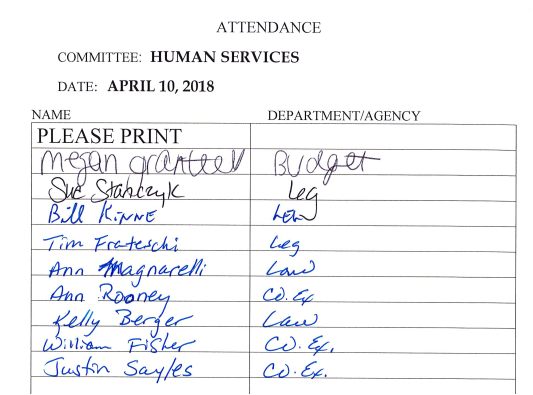
* * *
ENVIRONMENTAL PROTECTION COMMITTEE MINUTES - APRIL 11, 2018
MICHAEL E. PLOCHOCKI, CHAIRMAN
MEMBERS PRESENT: Mrs. Tassone, Mr. Burtis, Dr. Chase
MEMBERS ABSENT: Ms. Cody
ALSO ATTENDING: Chairman McMahon; see attached list
Chairman Plochocki called the meeting to order at 9:09 a.m. A motion was made by Dr. Chase, seconded by Mrs. Tassone, to waive the reading of the proceedings from the previous committee. MOTION CARRIED. A motion was made by Dr. Chase, seconded by Mrs. Tassone, to approve the minutes from the previous committee. MOTION CARRIED.
1. OFFICE OF ENVIRONMENT: Travis Glazier, Director
a. Amending the 2018 County Budget to Provide for use of Funds in Connection with the Onondaga Lake Waterfront Planning Project, and Authorizing the Execution of Agreements ($330,000)
Chairman Plochocki said that Brian May, Chairman of the Ways and Means Committee, requested that this item be presented as informational. Accordingly we will not be taking a vote today. With that being said, please pay close attention as there will be a point where we will be. Secondly, this is not county money, it is grant money, and I will let Travis (Glazier) discuss that.
Mr. Glazier presented the following:
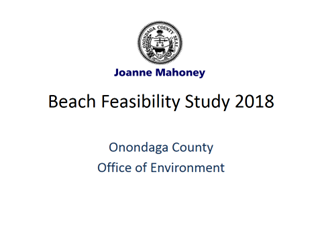 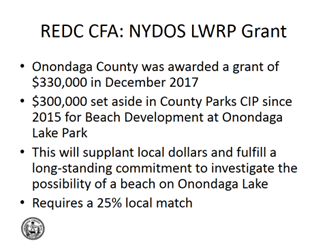
-
Resolution to accept funding, Regional Economic Development Counsel Combined Funding Application (RED CFA): NYS Department of State Local Waterfront Redevelopment Plan (NYDOS LWRP) grant; Holly Granat, Environmental Policy Analyst has been apply for grants, these funds supplant money the county already intended to spend
- *25% match, will turn $300,000 bonding into $110,000 local dollars (see pg. 4)
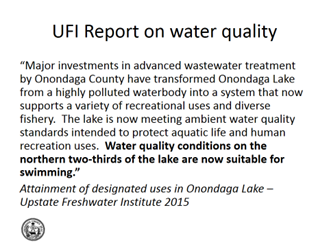 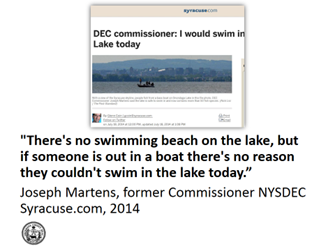
Mr. Glazier said, “For the record, Upstate Freshwater Institute has been the primary organization, citizen organization, independent organization, that has been reviewing data on Onondaga Lake for the better part of 30 years and when they came out and said that water quality conditions on the northern two-thirds of the lake are now suitable for swimming it was a significant movement. In addition, that study in 2015 showed that for 5 years straight those waters had been suitable for swimming and since that time they have remained suitable for swimming. So the conditions in Onondaga Lake are such that it can support public bathing.
- Key message - there is no beach on the lake
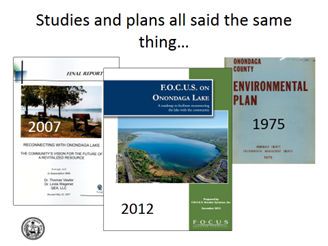 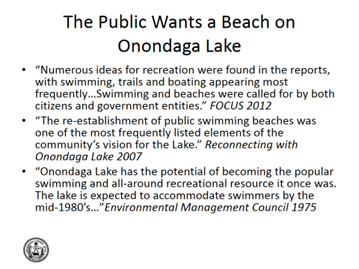
-
2012 FOCUS study was a study of that period and review of 80 years’ worth of studies already completed, 2007 Onondaga Environmental Institute studied reconnecting with Onondaga Lake, as far back as 1975 it was expected that the lake would accommodate swimmers by the mid-1980’s
 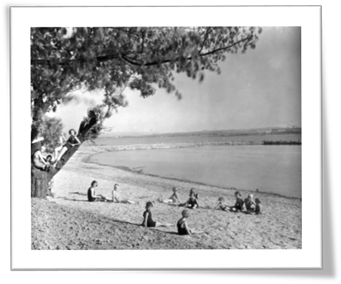
- Onondaga Lake have a history of beaches Beach located where the marina is now
 
- Danforth Saltwater Pools Beach on Willow Bay
 
- Long Branch Willow Bay looking directly across the lake
-
Public enjoyed beaches on Onondaga Lake, vacated due to issued related to contamination, those issues have now been dealt with, DEC and all regulators indicated the lake meets swimability standards, incumbent upon us to follow through and see if the $750,000,000 cleanup investment to Onondaga Lake can be enjoyed by the taxpayers once again
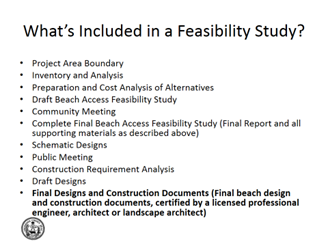 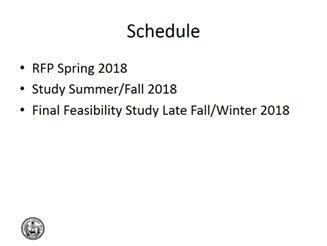
-
RFP not just feasibility study, includes design and construction documents, puts County in a position where they can make a decision, will have an idea of the costs and what investments have to be made to allow public bathing in Onondaga Lake
- Great deal of information provided, will take any questions
Chairman Plochocki said that the thrust of the study was feasibility and then asked if the study was broader than the beach, about the park in general. Mr. Glazier said that the grant, as an LWRP, encompassed the entire eastern shore of Onondaga Lake. There is a component of the grant that says visioning for the future of Loop the Lake, also a potential market study. We are in the process of working through a contract with the Department of State about which of those pieces will go where; there is potential public visioning for Loop the Lake and a potential market analysis for the Roth Steel site. The grant was applied for eight months ago and the thrust was what the Parks department felt the feasibility study would cost.
*In answer to Chairman Plochocki, Mr. Glazier said that the grant is $330,000 with a 25% local match and he apologizes, if his math is incorrect.
Dr. Chase said that $300,000 isn’t dumping a bunch of sand in an area. Mr. Glazier said that $300,000 is the feasibility study, which looks at infrastructure needs to support a beach and things such as aggregate, i.e. put aggregate in in the spring, don’t want to come back in the fall and have none of it there. Feasibility study will look at engineering impacts for waves, what the water does on a regular basis, material sources, and what the depths are; intention is to look at the entire eastern side of Onondaga Lake. Logically you can narrow down where the potential options are and in the end come up with a final design that will have an estimated price for the legislature to consider for actual construction of the beach. Dr. Chase said the besides the beach we are probably looking at a bathhouse and other supportive structures. Mr. Glazier said that this is what the feasibility study will evaluate.
Mr. Burtis said that he would imagine a few beach areas. Mr. Glazier said that the idea is to get a single location and consolidate our resources. Parks will have a big part in this to make the consultant understand their long-term plans, the physical restraints they see, and then get an evaluation from the contractor on whether those are hindrances or if there are ways to work with them
Mr. Burtis said that this money will also conduct future planning for Loop the Lake. Mr. Glazier said that there is $30,000 for maybe visioning what the public thinks about the eastern side, from Murphy’s Island to the Butterfly Garden, and the other area is a potential market analysis to try and understand what the financial impacts are. These actions, or financial impacts, are of other areas within the eastern shore that we have not clearly defined. The first thing is getting the beach analysis underway.
Mr. Burtis said that he is the only legislator present that actually jumped in the lake and submerged himself in the water, and he is ok. Mr. Travis said that he cannot say this enough, the water quality standards are such that they support public bathing. It is supported by fact, and you see it in reports time and time again. You can swim in Onondaga Lake, the northern two-thirds are Class B waters and they can support a public beach. Chairman Plochocki asked how much of a hurdle it would be to get the NYSDOH to approve the beach. Mr. Glazier answered that it wasn’t a hurdle; we meet standards by the EPA, DEC and DOH. If William’s Beach and Oneida Shores are supporting public bathing, Onondaga Lake will support it. Chairman Plochocki said that he is glad to hear it meets EPA standards. A few years ago, after Tim (Burtis) jumped in the lake, there was a letter from an EPA official; asked if it would be far to say that they are on board at this point. Mr. Glazier answered that the EPA provides guidelines for swimability standards and those guidelines align perfectly with DEC’s standards for a public bathing beach. While they are not an authority, which tells you can and cannot have a swimming area, their guidelines are perfectly aligned. That administrator’s statement was a statement of opinion and not a statement based on any policy that we have been able to locate under the EPA. Chairman Plochocki said that this was his sense at that time as well.
In answer to Chairman Plochocki, Mr. Glazier confirmed that water quality was not the issue of the feasibility study but would be part of the data included. The thrust of the study is the mechanics of what it would take to put in a beach. In addition, there is design. There is always a feasible way, it is a matter of costs and how you get to something actionable for the legislature and the Parks department. As the County, you should be excited about the potential because the lake has come so far. Twenty years ago folks would have chuckled to think that we would be here now. It is an exciting time to be part of Onondaga County.
Ms. Tassone asked if money set aside to stabilize the shore was connected to this. Mr. Glazier answered that the shoreline stabilizations are further south and not connected to this.
Chairman Plochocki said that this item will go on to Ways and Means.
No action was taken on this item.
2. METROPOLITAN WATER BOARD: William Fisher, Administrative Director
a. Confirming the Replacement of Assets Owned by the Onondaga County Water District
Mr. Fisher:
-
MWB has no employees, assets are managed by OCWA under a cooperation agreement approved by the legislature in 2016, effective Jan. 2017
-
MWB exists as a board of which he is the administrative director
-
Per agreement terms, any project above $500k requires approval of the legislature; OCWA decided to change the project for the Lake Ontario Water Treatment Plant, originally planned to use 2-speed drives, changing to variable speed frequency drives for the Raw Water Plant
-
Funded from CARE Project, limited to $14M, still within that budget, not asking for additional money, being asked to confirm replacement and upgrades to leased assets that still belong to us and are above $500k
Chairman Plochocki said that all committee member were on the legislature at that time and remember this situation, and why we still retain ownership and agreed to OCWA management. Everything is paid for, this is us just giving our blessing. Obviously, it would not be here if other officials in the County were not supportive of this.
Ms. Tassone asked how long the agreement was for. Mr. Fisher said for 20 years. Speaking for the County Executive, we continue to own the assets that are leased and levy an ad valorem charge on the water district. It is flat at $1,000,006. We continue to have county debt service, as we took out the bonds for this for example. At some point those bonds will be paid off and future legislators, 15 to 20 years from now, will decide if they want to continue the ad valorem. In the meanwhile, the cooperation agreement says that they will give us the money we need to service the debt because the ad valorem is not enough to service the full amount of the debt.
Mr. Burtis asked if the project is still expected to be completed by January 2019. Mr. Fisher responded that this is what we are being told by OCWA. It has been a challenging project. There were a lot of innovative parts to it, an energy performance contract and design build agreement. Mike Hooker, Executive Director of OCWA has been keeping the Office of the County Executive informed on the progress. A contract that we entered into with C&S Engineers is something they are not administering and at some point we may assign that contract to them. We are trying to send a message that this is on OCWA management and board. We are not going ask the County Legislature for any more money so you have to figure out how to work with the $14 million.
A motion was made by Mrs. Tassone, seconded by Dr. Chase, to approve this item. Passed unanimously; MOTION CARRIED.
3. WATER ENVIRONMENT PROTECTION: Tom Rhoads, P.E., Commissioner
a. ACJ Report
Mr. Rhoads:
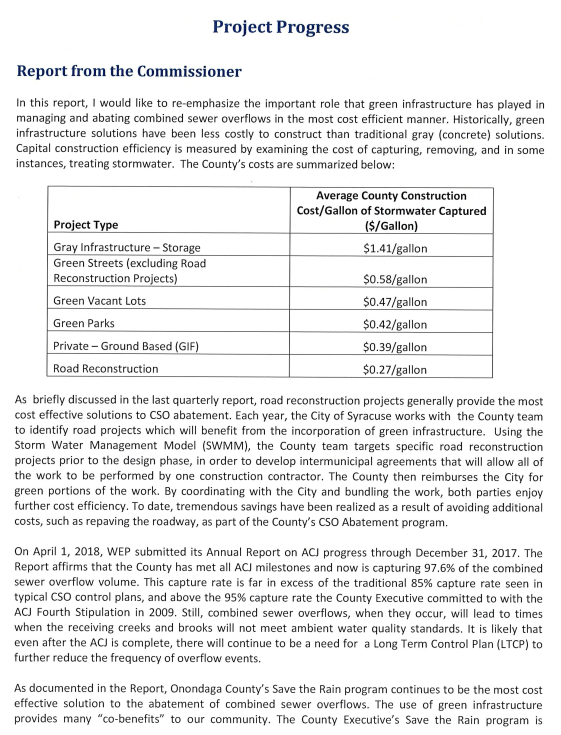
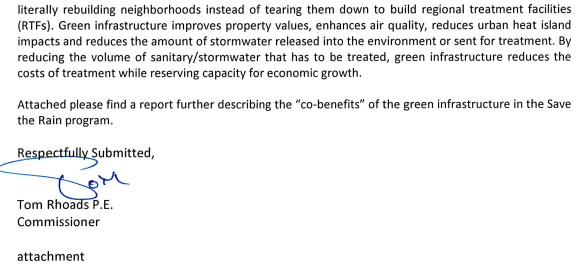
-
Gray concrete solutions were used to resolve sewer overflows in the past: built tanks, things at the end of the pipe, tried to treat stormwater already mixed with sanitary water, all those things were costing us; recent gray solutions were storage, Clinton and Lower Harbor Brook, even more expensive solution was sewer separation with recent separation costs about $3 per/gallon
-
Cost per/gallon shown in graph averaged over 200+ projects, green less costly by far and provides co-benefits; very detailed report, source material from across the nation as to benefits beyond stormwater capture, measure benefits as far as water quality improvements, avoided energy costs, improved air quality, long-term economic savings; hard time measuring other benefits seen, i.e. property value improvements, crime reduction; smallest fraction of green can improve property values and communities, doing a lot of community development work as well as saving money
-
No longer doing gray projects
-
Green projects include a number of street projects in the City of Syracuse for combined sewer areas, now into the construction season, several projects happening in and around the university neighborhood, timed to avoid neighborhood impact, i.e. gradation and move out season; instead of tearing down neighborhoods are rebuilding and working with neighborhood
-
-
Report contains all project costs, contractors, and work completed; remember road reconstruction projects are the best projects from a cost effective standpoint
Chairman Plochocki said that the biggest costs to redoing pipes, in many cases, is ripping up and putting back the road, which is why this is the most cost effective. Mr. Rhoads added that when the City is redoing a road we try to do this one cut process where we do our work in advance of theirs and they rebuild the road, which saves us a pile of money.
Chairman McMahon questioned where he would find the funding for Block the Litter in the report. Mr. Rhoads said that the public education portion of the program funds that campaign. Chairman Plochocki said that, as he understands it, one of the aspects of the ACJ is public education. The reason for that is that part of cleaning up the lake, when it comes to true litter, is getting people to stop littering, resulting in the educational component. From what has been discussed in the past, it is more than fair to say that the ACJ requires an education component of what we are doing at least. Mr. Rhoads said that the ACJ requires us to remove floatables, anything objectionable in the waterway. We have found that about 98% of the floatables associated with our receiving waters happen to be street litter. We have a number of floatable projects, included the public education component.
Chairman McMahon said that the County Executive mentioned street sweeping, in the City of Syracuse, in the State of the County address and he assumes it is related to capture of the litter. Mr. Rhoads said that is correct. Chairman McMahon questioned when the IMA is coming over between the County and the City. Ms. Tarolli answered that we will find out. Chairman McMahon said that there is no way this can be done without our permission, it was tried before; this is a great idea.
Mr. Rhoads said that in the past the EPA required us to install floatable control facilities and we have several of them throughout the City. They are giant trash racks that contain large net bags, which have to be moved in and out with cranes. It is very complicated to do, especially in the Plum Street area where neighbors don’t like us showing up and removing the icky nets in the middle of the workday. We installed millions of dollars’ worth of Floatable Control Facilities, and all we are doing is capturing everything that comes down the sewer outfall; creating giant leaf bags in the nets every time it rains in the fall and all kinds of sticks and debris every time there is a major windstorm. All that debris is still in the net bags along with street litter and other things. If these catch basins are not serviced, by the various roadway owners, they allow detritus to go through the catch basin, instead of being caught, and flow through into the receiving waters. In addition to public education we have done multimillion dollar capital improvement projects that have to be serviced after every rainstorm; very expensive to build and operate. We also run a skimmer boat around the Inner Harbor and net Harbor Brook, try to capture everything there with a floatables facility. We are doing all these other activities that are required by the EPA, DEC and ACJ. We have repaired and reconstructed well over 700 catch basins in the City. We found catch basins that we had to clean out. Basins should hold about a yard of material, and it had been a long time since some of those were serviced. They did not have hoods to retain the floatables so material would pass right through; have been reconstructing them. Not only are we paying for public education, we are paying an awful lot for gray infrastructure that needs to be maintained. In part, we are paying for deferred maintenance, and have found a national statistic that shows every dollar of deferred maintenance results to $4 to $5 dollars in future capital investment for every taxpayer. Catch basin deferred maintenance is not unusual, many communities have this problem. They are not taking care of their roadways and stormwater infrastructure and that allows these materials to go into receiving waters. We do not want people swimming around through coffee cups, soda bottles or other large scale debris. The more sustainable way to deal with floatables is source control. Trash cost $89 per/ton to get rid of in this community. To pick up each little piece of litter costs about $2,000 per/ton because it is aggregated and the resources required for all that work are tremendously more expensive than picking it up at the curb and putting it in the right place. The state approved a plan for floatable control based upon public education because removing it from the receiving waters is best done at the source. The more we do for source control, the more we avoid costs for significant capital and O&M expenditure. We have a lot of eyesores as the snowbanks melt, we have all seen it and know about it, there is a lot of work to do.
Chairman Plochocki said that the ACJ document does not specifically require public education, but it requires floatable control and it is very hard to do floatable control without source control. The key to source control is education and the floatable control plan, essentially everything we are doing as part of the ACJ has to be approved by the DEC. This was put before the DEC and they gave their thumbs up. At this point the DEC is not only expecting us to do public education on source control, but to actually report on it regularly. Mr. Rhoads said that this is correct. Chairman McMahon said that he just wanted to know how we are paying for it in the budget. He agrees with everything they are doing. Mr. Rhoads said that it is not in these capital budgets. It is actually paid for out of our regular yearly budget, as it is not a capital expenditure.
Chairman McMahon said that we are above schedule in meeting ACJ requirements. If he is reading this correctly, Clinton CSO has $12,315,000, Harbor Brook has almost $6 million and Midland has almost $27 million remaining in appropriated funds. Mr. Rhoads said that this was correct. Chairman McMahon said that projects are based on the effectiveness of capture for stormwater in certain geographical areas and those areas change. Mr. Rhoads said that it is looked at every year when we update the annual report. Chairman McMahon said that some of the CSOs’ are running a little light on funds. He questioned if they would be requesting to reappropriate money from Midland to other areas, depending on where the capture percentages are. Mr. Rhoads answered that, maybe 2 years ago, we reduced the Midland budget to increase the Clinton and Harbor Brook budgets. There are some interesting parts of this budget discussion. The available money is the authorized amount that we are allowed to spend, but we also received a number of grants and did not come back to increase the amount of authorization. Therefore, even when we have an authorized remaining amount, in this discussion it is the amount we have remaining for borrowing, typically we don’t have that authorization left for spending because the grants have already spent some of that down. I don’t plan on coming back anytime soon. It will be interesting to see how the DEC receives out current annual report. The world of combined sewers continues to change. Our community’s expectations are that there will never be any combined sewer overflow, and that seems to be the regulatory direction. There will mostly likely be long-term control plans to continue to drive down the amount of overflow allowed to be released. We made significant expenditures. It becomes a long-term control plan, a negotiation, a point of penetration with the regulatory agencies and your community as to what is the affordability to get that last gallon of capture. As we continue to capture more and more gallons the cost of capture goes up. Most of the remaining Harbor Brook Sewersheds are fairly small and we will be kicking Harbor Brook in the pants pretty hard this year with the remaining money. There are 1 or 2 significant projects in the Clinton Sewershed, a small section of the City of Syracuse, Walton Street, CSO 029, a very active combined sewer overflow that will be an expensive project. Also there will be long term benefits from the I-81 project, which will completely redo the way stormwater is managed, taking it out of the combined sewer system. Our long-term control plan is to spend local dollars on areas that are not going to be touched by I-81 and take a long slow look at how much additional local money needs to be spent on CSOs’ that will be abated, improved or mitigated by I-81. We do not want to get the cart in front of the horse and are not coming in for any more money right now. We have projects we continue to work on; most green street projects are in Midland 060 and 077. We continue to make improvements, which are required to improve the local receiving waters.
Chairman McMahon asked to be provided with updated CSO numbers for the amount available for projects. Mr. Rhoads said that our goal is to stay within the budget and use grant money to reduce our local costs. Chairman McMahon said that this is great. This money is already authorized and he is interested in knowing what is there because often times he is approached by projects potentially within these CSOs’ and it would be good be educated on what is available. Mr. Rhoads said that we do not have a lot of extra money in the tank. Chairman McMahon said that it is getting tight.
Chairman Plochocki dismissed Mr. Rhoads. Mr. Rhoads said thank you.
Chairman Plochocki asked if there was anything further. Dr. Chase asked if we have come to any agreement with the Native Americans regarding land. Chairman Plochocki said that we have not. Dr. Chase asked if it would happen before the beach. Chairman Plochocki responded that he would like to think so. Progress has been made and he would be happy to talk with her following the meeting. In answer to Mr. Burtis, Chairman Plochocki confirmed that this was just a study for the beach, but Peggy (Chase) was talking more long-term.
Chairman McMahon said that he assumes it would take an actual vote from the legislature to create a beach on the lake; knows they don’t have to put money in that budget, but questions who authorizes it. Ms. Tarolli answered that her guess is that they will need appropriation to come back to the legislature.
A motion was made by Mr. Burtis, seconded by Dr. Chase to adjourn. Motion carried.
The meeting adjourned at 10:07 a.m.
Respectfully submitted,

KATHERINE M. FRENCH, Deputy Clerk
Onondaga County Legislature
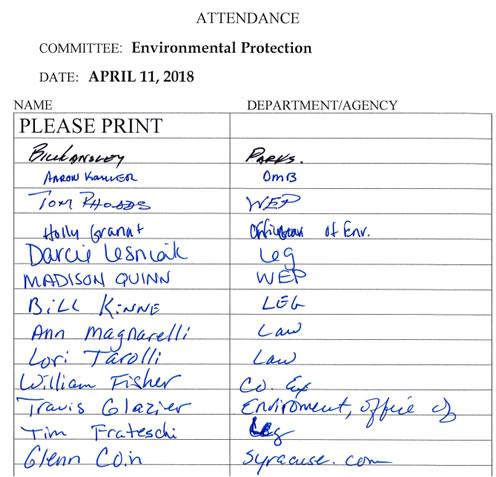
* * *
COUNTY FACILITIES COMMITTEE MINUTES – APRIL 11, 2018
JUDITH A. TASSONE, CHAIR
MEMBERS PRESENT: Mr. Holmquist, Mr. Knapp, *Mrs. Ervin
MEMBERS ABSENT: Ms. Cody
ALSO ATTENDING: Chairman McMahon; see attached list
Chair Tassone called the meeting to order at 10:35 a.m. A motion was made by Mr. Knapp, seconded by Mr. Holmquist to waive the reading and approve the minutes of the previous committee meeting; MOTION CARRIED.
1. CNY ARTS: Stephen Butler, Executive Director
a. Amending the 2018 County Budget to Make Funds Available to CNY Arts ($125,000)
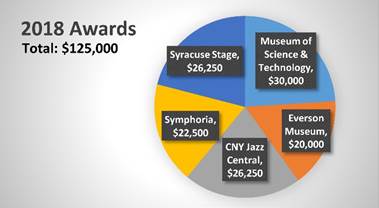
- Fund arts projects to create economic development for the County
-
Giving out grants for 5 years (since 2013); focusing on economic development (not economic activity) - bring people in County with new money to spend here, and train them to come back to County more frequently
-
i.e. Someone comes to see “Elf” at Syracuse Stage; hope they come back for other shows at Syracuse Stage, or even convert to subscription
-
Projects vetted by panel of those without conflict of interest – people from other industries and/or out of County; they’ve already made their decisions on the projects; amounts are set if approved by Legislature
-
Money is part of 22%; set aside to generate projects specific to economic development and tourism
Mrs. Venditti confirmed for Mr. Knapp that it is coming out of Room Occupancy Tax. Mr. Knapp commented that the Planning agenda shows a good amount of money for the bowlers, and Mrs. Venditti said that is coming out of surplus. Chairman McMahon commented this is in a contingency account.
Chairman Knapp asked Mrs. Venditti to have an update on Room Occupancy Tax for Ways and Means. Mrs. Venditti answered yes.
A motion was made by Mr. Knapp, seconded by Mr. Holmquist, to approve this item. Passed unanimously; MOTION CARRIED.
2. ONCENTER/WAR MEMORIAL: William Fisher, Deputy County Executive
a. Amending the 2018 County Budget to Provide for Improvements at the Oncenter in Connection with Grant Funds from the Empire State Development Corporation’s Market NY Grant Program, and Authorizing the Execution of Agreements ($975,000)
- Correction – accepted grant of $975,000 out of Market NY for Oncenter
-
Aug 1, 2017 - accepted money into Provision for Capital Projects, which is part of operating budget; at end of year, operating budget ends and appropriations to Provision of Capital Projects expire
-
Money not spent; currently procuring goods and services; need to reapprorpriate money; suggest putting into Capital Project account, which does not expire; not tied to budget or year
-
Will be able to spend money on same purposes discussed last year
-
Project: Marriot Syracuse downtown raised bar - meeting spaces, A/V, video signage, conference center, etc.
-
Disconnect for those using both Marriot and Oncenter; bringing meeting spaces, A/V, signage primarily in meeting space area and at base of escalator; also some in Exhibit Hall
-
SMG put together solid plan based on expertise and programming and convention center; lot of technology
-
Informal meetings and speed networking can facilitate use of hallways
-
Plans have not changed much
- Wi-Fi is already funded
Chairman McMahon responded to Mr. Holmquist that there was a formal proposal presented on the items, and it has been discussed. Mr. Holmquist asked if it is expiring because it is not in a capital project account. Mr. Fisher replied that at the close of the 2017 budget, the revenue was still there, but it currently cannot be spent. By appropriating it into a Capital Project, it can be spent.
A motion was made by Mr. Knapp, seconded by Mr. Holmquist, to approve this item. Passed unanimously; MOTION CARRIED.
b. INFORMATIONAL: War Memorial Arena Naming Rights – Update
Mr. Fisher:
- Greg Tripoli, Executive Director at OHA - working with Executive’s office and veterans groups
- John Paddock – Chairman of committee of veterans that advise the County Executive and others on projects
- Not renaming the Onondaga County War Memorial – County Executive Mahoney believes that should be the name
- Memorial Hall will remain Memorial Hall – any naming of the arena will not impact what is seen in Memorial Hall
- Arena could be what is renamed; engaged in dialogue with veterans
-
Senator DeFrancisco obtained $750,000 grant – $500,000 will go to Assembly Hall, $250,000 will go to upgrading veterans exhibits; working with OHA to ensure museum quality curation of exhibits is done
- Gold Star Mothers exhibit will be impacted - relocate; make sure everyone is comfortable with it


 
-
Center hung scoreboard; 4 panels; space on bottom for Crunch logo and sponsor name; ability on sides to have static sponsor or digital LED sponsorship; 4 places on top for sponsor’s name
-
Current lease with Syracuse Crunch gives them exclusive rights to sell advertising within arena
-
County and SMG can sell on concourse and outside the building on the marquees
-
Crunch has sole right to display advertising during their games; impossible to display naming rights sponsor without the consent of the Crunch
-
Crunch has right in lease to declare a certain company as an exclusive in a certain business category; i.e. exclusive bank or casino; County unable to have naming rights deal with company in violation of the lease
-
Working closely with Crunch and Law Department as SMG finalizes extension to Crunch lease – Crunch rights and County’s rights to revenue from naming rights clearly spelled out
-
If and when there is a naming rights sponsor, County Executive will bring to Legislature for approval
-
Can receive money, but cannot be spent without Legislature appropriating; make sure what decisions are made have Legislative approval
 


- Working on concept - speaking with veterans and OHA
- Speaker box above stage not used during hockey games or Disney on Ice; it is used for high school graduations
- Interferes with message “In memory of Our Service Veterans” - speaker box in the middle
-
Move speakers to another place; take same lettering from 1948 – preserve original design
-
Bigger impact above stage reminding everyone why the building was built
-
Mural – OHA has photos and imagery from the 5 branches of military and reserves; 10th Mountain Division and 174th Fighter Wing; may be able to create high impact visual
Mr. Tripoli:
- Working with Anthony James Partners by providing images from local participation in conflicts to incorporate in mural
- Images are from every conflict; contractor explained concept, and OHA supplied images that would fit
- Anthony James Partners will begin artistic component within a week
Mr. Fisher:
Mr. Tripoli:
- Want to bring all into same area; wall provides only 2 fields of information - name and service
- Digital display offers lots of information subject to what’s provided for each veteran; includes images for battles served
- More interactive; easily updatable (i.e. if miss someone); vs. a wall cast in stone - no revision
- Remotely accessible – people can provide info to central location; County will vet info before going into digital display
Mr. Fisher thanked John (Paddock) for getting the word out. There is a website available for people to submit suggestions, and John has a subcommittee that has been reviewing these.
*Mrs. Ervin arrived at the meeting.
Mr. Fisher said Commissioner Wixson assigned Greg Hallett, Architect and Navy Veteran, to be the point person to advance designs. With advance designs they can figure out how much things will cost, how it will fit in the budget, and how best to spend the money. Mr. Tripoli stated they do not want to reinvent the wheel. Perhaps there are other military museums that have similar set ups to track their veterans, and their service; instead of paying someone to develop software. It also helps to have the request come from the Admiral.
Mr. Paddock:
-
Advisory Board is a volunteer group – using process that takes suggestions, hands them over to experts, then comes back to the board to be looked at to make sure it makes sense
-
Ensure interests of veteran community are represented and protected; if issues of protocol or concepts, it can be done
-
2 pieces:
-
1st - This is starting dialogue, which has been productive in many ways that goes beyond a particular project; together with Crunch and others in community - create an appreciation and understanding of what the County has
-
2nd – Do not want ideas to fall on deaf ears or get lost; may not be appropriate for the War Memorial, but may be applicable to many other facilities; i.e. Cemetery, Amphitheater, Oncenter
-
Last 3 months very positive; asking to add representation of broad base of veteran community to membership; American Legion, Veterans America, Clearpath, etc.
- Folks engaged to represent every generation since WWII; good appreciation of what they’re about
Mr. Fisher:
- Heard interesting ideas and things that work in other places
-
1 idea: Reserve a seat on either side of arena to remain empty to honor those missing in action; Crunch like the idea, and it will be in the revised version of lease; will have to figure out how to do that, and how to fit it in the overall design
-
Looking for input from veterans and Legislature – what are things that commemorate services and honor
-
Do not want corporate logos on that end; ensure veterans are 100% in approval of design; concept only
-
Take some scattered items in arena, and with consent will move more towards Memorial Hall or Assembly Hall; Memorial Hall focus is more on veterans
-
Medal of Honor wall – protected from people spilling drinks on it, but may find better place closer to Memorial Hall; not in a sports bar type area
-
Trying to reduce impact on County tax payers; generating more from food and beverage will help
Mr. Tripoli commented that they have provided images for screens and LED. There is great opportunity to present images depending on the activity happening. i.e. Images of sports during sports events, and same for concerts. This will bring the local history of the building into play on the screens.
Mr. Fisher:
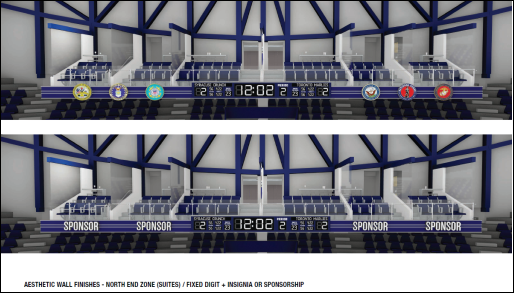
-
Opposite end of the ice; suites - bids open, came back within budget, and awarded; on track to get suites built in time for concert on Sept. 21; 2018-2019 season suites will be ready
-
Concepts – scoreboard to be used by high schools or clubs that would not be able to afford to use billboard system
-
Places for sponsorship or military insignia; asking veterans and Legislators to weigh in on if it’s the appropriate place to display insignia or is it better for sponsorship signs?
-
6 suites with 2 rows in each suite; high top and wheel chair accessible spaces; all ADA accessible
-
Total of 84 tickets within suite area; suites open into Assembly Hall (make sure it’s excellent for veteran’s meetings)
-
Committed that veteran’s meetings will have standard configuration, and it will be free to use; if they want something different, and labor is involved, then it will be at a cost
- Also provide free parking when using Assembly Hall space; standard contract; SMG gives vouchers for parking
Chairman McMahon:
- Great job; War Memorial to be transformed; lot of what they saw has funding appropriated
- Naming rights new revenue opportunity to potentially make improvements honoring the veterans
- Mural with OHA concept is not currently appropriated money from what has passed (Mr. Fisher agreed)
- With naming rights deal, could move forward with mural, and appropriate
Mr. Fisher explained the bid is an ad alternative, so the base bid would not include this. If they go forward with this, then this is the bid. Mr. Fisher will know relatively soon how much it will cost to pull the trigger on this option (mural), and they have already received preliminary pricing. The deals SMG and the Crunch are talking about would accommodate everything the committee has seen. Chairman McMahon asked if Mr. Fisher has a framework on the naming rights. SMG manages the facility, and the Crunch have exclusive rights to work around, so how does Mr. Fisher envision the naming rights opportunity being presented to the Legislature. Mr. Fisher believes there’s a good chance the Crunch will narrow it down to a single sponsor in time for May committees. Mr. Fisher may be ready to come over in May with a proposed deal, sponsor name, how the money will be used, a resolution accepting the funds, and a resolution appropriating money. Chairman McMahon wanted clarification of how the Crunch are involved. Mr. Fisher responded:
-
Crunch lease gives them exclusive rights to sell advertising within the arena; County has rights on concourse, but those are subject to the Crunch’s rights to name exclusive business category sponsors
-
If they sell exclusive to (i.e.) a car company, then the County could not sell advertising on the concourse to any other car company except that car company
-
Folks presenting events are in sponsorship business; try to support business by choosing sponsors who want their brand to be identified with a concert or hockey game
-
Silver Knights do not have same financials as Crunch - digital displays allow them to change signs quickly
-
Working on extension to Crunch lease with SMG; willing to go 12 years beyond current year; finalize agreement with SMG and Crunch; making sure Crunch’s rights to sell advertising tie out to County’s ability to sell sponsorship rights
-
Extension to lease, and Legislative resolutions could be brought together for May committee to be voted on in June
Chairman McMahon said there are live comparables within the NHL, and assumes Mr. Fisher will bring over a deal that is as good, if not better. Mr. Fisher said yes. SMG is out there, and they have been gathering market research to establish what the market price should be. Chairman McMahon thanked the Admiral for his work, and asked that they cast as wide of a net as possible. This is not a revenue grab for the County. It is about restoring the facility to what it once was to honor the veterans, and host other tenants.
Mr. Paddock:
Chairman McMahon asked if there will be signage (for the naming of the arena) on the outside of the building, or only in the arena. Mr. Fisher stated the County Executive does not want to see the name of the arena on the building. Above the marquees it will say the Onondaga County War Memorial. They will not change the Memorial Hall entrance either. There may be signs in the ground that say “Fill in the Blank” Arena at the Onondaga County War Memorial, which the Executive would not be opposed to. Looking at signs possibly facing Montgomery and State Street.
Mr. Knapp thanked Mr. Tripoli and his team for all of their hard work and help with this.
3. TRANSPORTATION: Martin Voss, Commissioner
a. A Resolution Authorizing the Reconstruction of County Roads in and for the County of Onondaga, New York, at a Maximum Estimated Cost of $5,700,000, and Authorizing the Issuance of $5,700,000 Bonds of said County to Pay Costs Thereof ($5,700,000)
- Chris Rauber – taking over Highway Work Plan; Civil Engineer 3
- Came last month and gave informational on process and financing of work plan
- (Highway Work Plan on file with the Clerk)

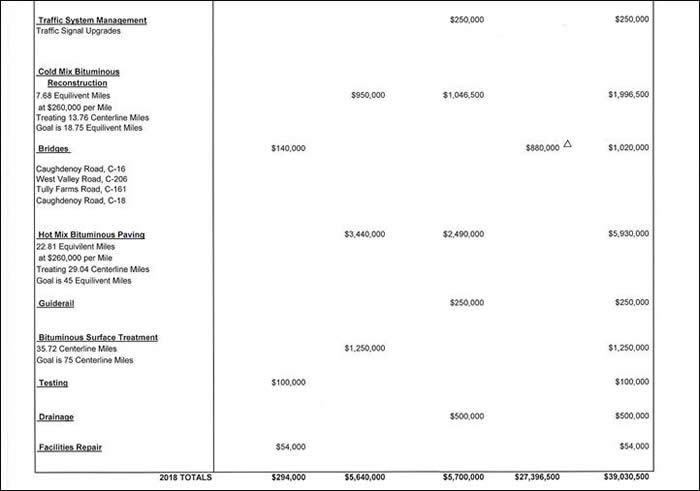
- Traffic System Management – traffic lights
- Cold Mix – rural and low volume roads
-
Hot Mix – high volume, intensively used roads (i.e.) Rt. 57
-
Guiderail done every year
-
Bituminous – pavement preservation (on top of cold mix); every road that gets cold mix gets bituminous, but not ever road that gets bituminous gets cold mix; bituminous is a coating that protects, preserves and extends the life of the road
-
Testing – vendor goes out; figures out what needs to be done and why
-
Drainage – materials for culverts and bridges
-
2018 Work Plan – last year started with $1.39 mil; July 2017 $1 mil removed from cash budget; Oct. 2017 $200,000 taken out at budget time; left $294,000 in cash
-
Projecting CHIPS to be same as last year; bond – $4.6 mil borrowed last year and added $1.1 mil cut to still do work
-
Majority of federal and state aid; all in County cash $294,000 leverages over $39 mil of work scheduled
-
Big items go through multiyear process through SMTC (Syracuse Metropolitan Transportation Council); Chris (Rauber) finds out how and where money is for funding
-
Maintenance work – potholes, curbing, medians bulk of local plan
-
Bigger tickets – under current scenario for every $0.5 get $0.95 back; 80% from federal government

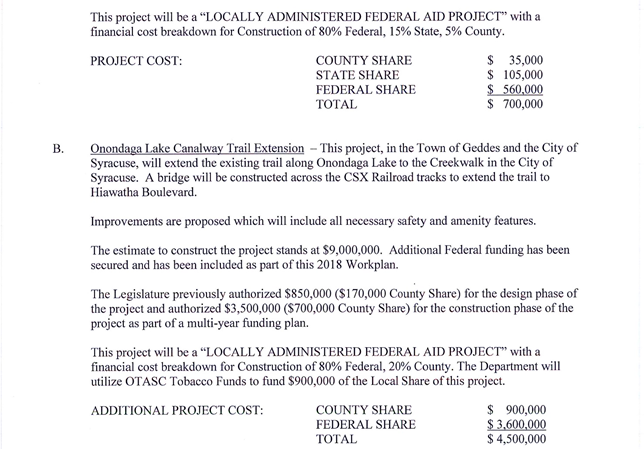
Mr. Knapp clarified that they are going from Honeywell pump station to Harbor Brook, and Mr. Rauber said yes; then Harbor Brook to Hiawatha.
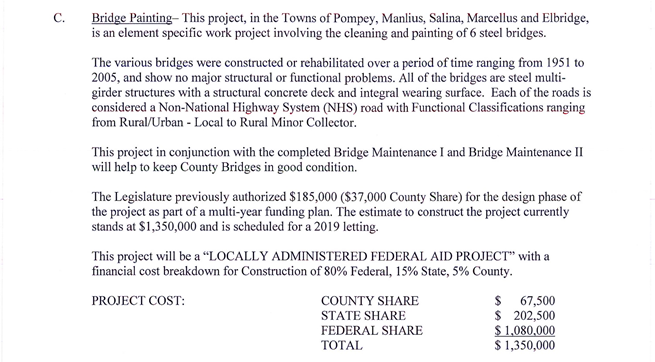
- Bridge painting – various areas need cleaning and painting; design already in work plan

- Buckley Road – too much for hot mix; federal aid project; $1.3 mil; next spring
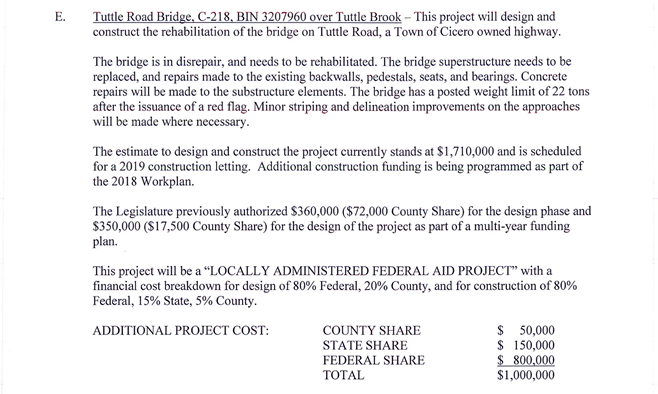
- Tuttle Road Bridge – Cicero – replacement $1 mil


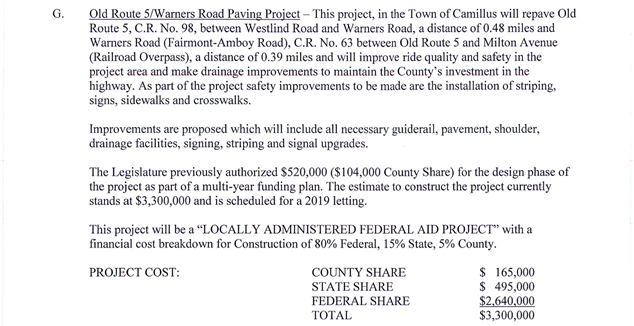
- Rt. 5; Warners Rd.; W. Genesee St – busy area; working with Town of Camillus on phasing and staging
- $3.3 mil; in front of Fairmount Wegmans up to 173; major project for next year
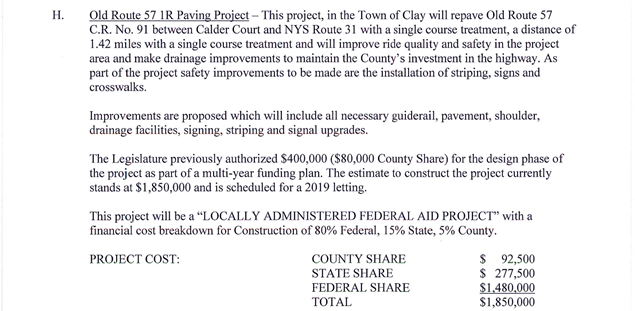
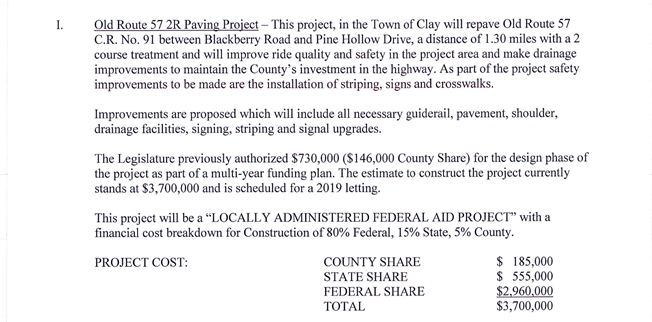
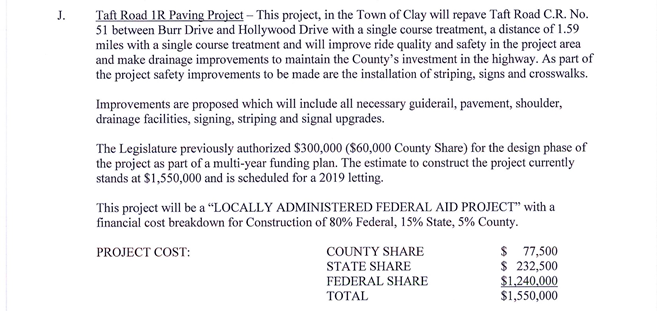

- Number of other stages of projects; each take couple years to go from concept to design to construction

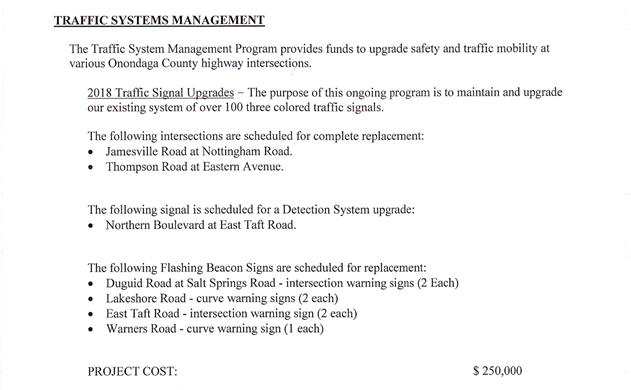
- Bridges – Caughdenoy Road in Town of Clay over Young’s Creek $200,000; West Valley Road in Town of Spafford; Tully Farms Road over Blue Hole Creek in Town of LaFayette $280,000; Caughdenoy Road over Oneida River $210,000; normal maintenance and cleaning
- Hot Mix anticipate $5.9 mil; Guiderail $250,000; Bituminous $1.25 mil; Testing ~same; Drainage ~same
- Project lists in back – based on consultant review and DOT review; worst to first
- Bond supports local share of federal aid projects, and a portion of hot and cold mix
Chair Tassone clarified that this item is for bonding $5.7 million for the Highway Plan.
A motion was made by Mr. Knapp, seconded by Mrs. Ervin, to approve this item. Passed unanimously; MOTION CARRIED.
b. Amending the 2018 County Budget to Pay in the First Instance 100 Percent of the Federal and State Aid Eligible Costs at a Maximum Amount of $5,367,500 for the Electronics Parkway 2R Paving Project, Pin 3755.71, and Authorizing Execution of Agreements ($5,367,500)
-
Pay in first instance for Electronics Pkwy; show NYSDOT and FHWA (Federal Highway Administration) that County DOT has authorization to start project
-
Gives ability to contract with state; state handles FHWA process with DOT; ability for DOT to front money for reimbursement later from the state for construction phase; bid over summer for construction next year
-
Process: present SMTC with projects that need to get done; get them funded and approved in (i.e.) TIP (Transportation Improvement Program), TAP (Transportation Alternatives Program) through SMTC; projects approved at local level this way; insular groups that take things on merit and need
-
Then go through local process with Management & Budget; figure out how to pay and put pieces together
-
Once have contract and Legislature approval, go back to state; sign paperwork to go to NYSDOT that certifies the work is approved and being done
-
Reimbursement - as costs incurred they are constantly processing the paperwork; processed weekly, which goes to state, who has federal money
-
NYSDOT great about reimbursing money; Chris (Rauber) an expert at system
-
There are no projects that have not been paid through NYSDOT
A motion was made by Mr. Knapp, seconded by Mrs. Ervin, to approve this item. Passed unanimously; MOTION CARRIED.
Mr. Voss responded to Mr. Knapp that they do not know the severity factor yet. Mr. Voss has seen some preliminary numbers of CHIPS, EWR (Emergency Winter Recovery) and Pave NY. There is nothing official yet, so DOT cannot give the Legislature a resolution without real numbers. Mr. Voss hopes to come back in May or June with Pave NY money, EWR money and Severity Factor money on a resolution to be accepted.
The meeting was adjourned at 11:38 a.m.
Respectfully submitted,

JAMIE McNAMARA, Assistant Clerk
Onondaga County Legislature
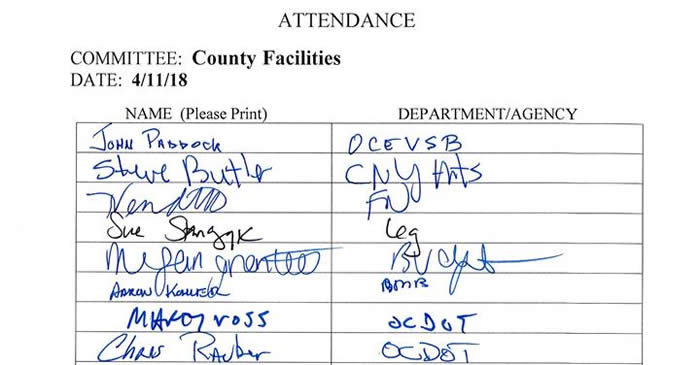
* * *
PUBLIC SAFETY COMMITTEE MINUTES - APRIL 11, 2018
CHRISTOPHER J. RYAN, CHAIRMAN
MEMBERS PRESENT: Mr. Bush, Mr. Jordan, Mr. Rowley, Mr. McBride
ALSO ATTENDING: Mrs. Ervin, Chairman McMahon, Mr. Knapp; see attached list
Chairman Ryan called the meeting to order at 12:04 p.m. A motion was made by Mr. Jordan, seconded by Mr. Rowley, to waive the reading of the proceedings from the previous committee. MOTION CARRIED. A motion was made by Mr. Jordan, seconded by Mr. Rowley, to approve the minutes from the previous committee. MOTION CARRIED.
1. JUSTICE CENTER OVERSIGHT COMMITTEE:
a. Confirming Appointments to the Onondaga County Justice Center Oversight Committee (Carlton Strail, Nicholas Paro, Cassandra Jones Ingram) (Sponsored by Mr. McMahon)
Chairman Ryan said that there is one reappointment and two new appointments due to members coming off before the expiration.
Mr. Rowley said that he brought this up before. Now that the Sheriff has oversight of Jamesville, was there any talk of expanding the oversight committee to include Jamesville, or is that a different animal. Chairman Ryan responded that this is good question and something we should talk about. Ms. Lesniak said that it was in the works. Chairman Ryan said that it makes perfect sense, he would be supportive and looks forward to it coming back. (*cont. pg. 3)
Mr. Bush said that he recently attended the Justice Oversight Committee meeting and they are looking forward to having these slots filled. Chairman Ryan said that it is a good committee, which we got up and running; same thing with the Human Rights Commission. They do a lot of good work and it is good for the community. When this was being setup they brought up a lot of people, which is integral. Having good people serve and making it a full committee is imperative.
A motion was made by Mr. Rowley, seconded by Mr. Bush, to approve this item. Passed unanimously; MOTION CARRIED.
2. EMERGENCY COMMUNICATIONS: William Bleyle, Commissioner
a. Amending the 2018 County Budget to Accept Funds from the New York State Department of Homeland Security and Emergency Services’ Public Safety Answering Point (PSAP) Grant Program, and Authorizing the Execution of Contracts ($177,652)
Mr. Bleyle introduced himself to the new members. Chairman Ryan said that before we get started, E911 does a great job and is quite an operation. If everyone is agreeable we could have a Public Safety meeting and tour there. Mr. Rowley said that it would be great. Chairman Ryan said that 6 or 7 years ago the Public Safety Committee had a tour of 911. They also had a meeting at the Justice Center and the DA’s office, but we will start with Bill (Bleyle) first.
Mr. Bleyle:
- 2 items on the agenda, both grants
-
2a is a Public Safety Answering Point (PSAP) grant, money allocated by the state, can be used for various PSAP expenses, memorandum of support contains the list of expenses
-
Two primary expenses:
-
implement Automated Secure Alarm Protocol (ASAP), a program that is a joint partnership with the Central Alarm Association that represents all the alarm companies, (APCO) the Association of Public Safety Communication Officials that represents all the communication centers across the country and the federal government, uses secure data lines of the National Law Enforcement Telecommunications System (NLETS) to link the Computer Aided Dispatch system (CAD) together between participating alarm companies and E911, currently every alarm generates 3 calls back and forth – 1st alarm reported, 2nd call 911 to tell them who is responding to meet the police, fire department or ambulance, if the subscriber is not at home, 3rd call E911 contacting them back to let them know the outcome of the alarm, this eliminates the need for those calls, the call taker at the alarm monitoring center will enter the information into their CAD system and within seconds it will appear in our dispatchers screen, will save significant amount of time; Monroe County implemented 1 year ago, saves at least 2 minutes on the dispatch of an alarm
-
improve text to 911 interface, currently receive text to 911 messages from all 4 major carriers on a web based interface, not as reliable as it needs to be, subject to higher failure than direct interface, hope to have direct link with carriers, allows text to come directly into our system like a regular phone call
In answer to Chairman Ryan, Mr. Bleyle said that this grant money will fully implement both projects. Any operational expenses left over will be put into our budget. Last year we had left over money that was used to put into our personnel account. The contract was settled and pretty much everyone’s personnel line was short; can be used for certain operational expenses.
-
Don’t get a lot of text messages, a high percentage of them are from hearing or speech impaired, very valuable to them in terms of accessing 911, want to make sure we have the most reliable service for them
Mr. Jordan asked if this was additional work or already planned for in this year’s budget. Mr. Bleyle answered that both this and the next item are things on their wish list. We try to avoid capital expenses for a lot of things, in particular the next grant that I am going to talk about. We were asked to keep our budget less than what we were at last year, so we have to prioritize. These are some things we feel we really need, but are not able to get through normal budget funds. Mr. Jordan said both involve work that we did not plan on doing this year but now we are going to move forward because we got the grants. Mr. Bleyle answered, yes on this one. The next project was in the CIP plan, have been holding off for a little while in hopes that we would get the grant money to fund it. Mr. Jordan said that we have a five-year CIP, is the next project something we had already planned to do and budgeted for in this year’s plan. Mr. Bleyle said that it was planned for last year but he pushed it off because we actively try to pursue as many grant funding opportunities as we can; don’t want to come for CIP items if I don’t have to. In answer to Mr. Jordan, Mr. Bleyle confirmed that the plan for the second item was to borrow the money as it is over a million dollars. In answer to Chairman Ryan, Mr. Bleyle confirmed that there are no local dollars; 100% state paid. This is money we receive from the state, on a year-to-year basis, depending on the legislature. It is some of the wireless surcharge money, which the state receives, coming back to us. In answer to Mr. Jordan, Mr. Bleyle confirmed that both projects are zero local dollars.
A motion was made by Mr. Rowley, seconded by Mr. Jordan, to approve this item. Passed unanimously; MOTION CARRIED.
b. Amending the 2018 County Budget to Accept Funds from the New York State 2017 Statewide Interoperable Communications Grant Program, and Authorizing the Execution of Contracts ($1,360,003)
-
Money earmarked strictly to support interoperable communications, particularly radio systems, has been in the CIP for a while, adds some redundancy to our radio system, currently maintain the radio system used by most/every public safety agency that operates in Onondaga County at various levels, county municipal, public safety, state and federal, currently about 150 users, both public safety and public service, i.e. DOT, DPW; 8,000 to 9,000 radios attached to the system
-
Digital radio system, IP based, if computer doesn’t have a connection with the network there is no radio; radios are like computers, have IP addresses, important to keep system operating 24/7, sought additional backup, currently the entire master site is located in the 911 center, number of redundancy within that secure site but if something catastrophic happened to that center the radio system would cease to serve all agencies
-
Entire funds will be used to build geo redundant radio system prime site or master control at one of our tower sites scatter around the county; currently maintain a microwave system in a sonic ring, goes around the entire county, if we were to lose our building on the hill the microwave systems would reverse themselves and redirect all traffic to that prime site; quote from Motorola $1.3 million, funds pay for entire project
Mr. Jordan said that he thought there was a redundant system in the basement of the Civic Center or County Office building. Mr. Bleyle said that there is a backup site in the subbasement of the Civic Center. This week we will be going to the backup site for 1.5 days because we have major generator repairs and do not want to risk a power failure while doing that work. Also taking this opportunity to do heavy-duty cleaning of our operations floor and other things. Most of the systems we use are housed in more than one place, with the exception of our radio system, they have geo redundant locations. Mr. Jordan questioned if the system at the Civic Center included the radios. Mr. Bleyle answered that it includes an operations floor with all the dispatcher and call taker positions, but they connect back to the radio system by microwave and fiber and if we lost the radio system they would have nothing to connect back to. In answer to Mr. Jordan, Mr. Bleyle confirmed that we are creating a geo redundant radio system. Chairman Ryan said that making these improvements to existing infrastructure was something that they had been planning to do. Mr. Bleyle confirmed this was correct, adding to ensure redundancy.
A motion was made by Mr. Jordan, seconded by Mr. McBride, to approve this item. Passed unanimously; MOTION CARRIED.
Mr. Bleyle and Chairman Ryan thanked each other.
*Chairman Ryan said that including Jamesville Corrections in the Justice Center Oversight Committee is a takeaway, which will be coming back.
Mr. Bush said that he had some agenda items for the Chairman’s consideration:
-
Supervisors are interested in having the County take back the Animal Abused Funding program, county maintained for several years then discontinued, it fell to each individual municipality, feel it is a countywide issue and should be handled by the County, as it is in Oneida County with the CNY SPCA
-
Propose revenue sharing funding stream to municipalities that run police services, feel they are the first in line for county safety, each call they answer is one less the Sheriff or NYS Police have to answer and the County should help with some operating costs for local police agencies
-
Per lawsuit Onondaga County had to provide lawyers at arraignment, setup Centralized Arraignments from 5-10 p.m., judges are paid but who pays the clerks, arrangements more than traffic tickets, complicated and need clerk support; not sure what committee this goes to, received letter from town in his district saying that this is an unfunded mandate that is being passed down to the local taxpayers, just bringing this to your attention, maybe you can guide it someplace, sure others will be hearing from towns about this cost as well
Chairman Ryan said that we had lengthy discussions about the lawsuit and arraignment last year and asked for confirmation of the issue. Mr. Bush answered that they did not have legal representation, which they need. The program put in place seems to be working, but there are a few bugs. It works better in terms of representation for the accused, and is just a matter of implementing it all the way through. The judges’ part seems to be working, it is just how the staff support, which they need, will be paid. Chairman Ryan said that all the feedback has been that it is working pretty well; there may be some costs associated with it. Mr. Jordan said that currently there is no requirement for a clerk, it is the decision of the judge. Some judges don’t have a clerk, others do and pay their clerk out of the money they receive for doing Centralized Arraignments. Chairman Ryan said that this could be discussed further.
In answer to Chairman Ryan, Mr. Bush said that the revenue sharing would be a formula based on population served, i.e. town covers 24,000 people that would be the baseline. Mr. Rowley said that they could consolidate their police department. Mr. Bush said that they could and then we will worry about what kind of coverage they will get. Mr. Jordan said that based on past experience the coverage will improve.
Mr. Bush said that Jordan Elbridge just hired SROs’ in all their school buildings and Baldwinsville is hiring 2 additional. It is a larger district that can’t afford to do every building but it is their goal. This is spreading throughout our society, schools with SROs’ and communities with local police departments are relying more and more on that level of public safety. I think the County should help support those police departments. They are saving the Sheriffs and troopers from having to cover that area. Chairman Ryan said that on the flipside we are not going to force anyone to do anything they don’t want to do. As a member of the Geddes Town Board, for 6 years, there were a lot of discussions about Geddes and Solvay possibly coming together and sharing an investigator or road patrol, and nobody wanted to do anything. It was frustrating, as the taxes in the Town of Geddes are significant and savings could have been realized by consolidation, greater collaboration or sharing of a chief. There was funding for a consolidation initiative and there was talk of one chief retiring and some union contracts were going to be expiring, which would provide the ability to combine the union issues. It was frustrating because we could have reduced the amount of money to the taxpayers and maintained the same level of service.
Chairman McMahon said that we have struggled with this for years. The menu of services our Sheriff’s department delivers and what they are chartered do deliver are different, and some towns have taken advantage of that. Before towns didn’t have their own police departments, Jim (Rowley) could speak about what happened in Clay. We offer road patrol but that is a big budget number and the Sheriff is not chartered to have a road patrol. The Sheriff is only chartered to run the jail. To Chris’s (Ryan) point, I represent the Town of Geddes and Solvay, and several years ago there was a hostage situation in Solvay In that one situation, you had the NYS Police, the Sheriff’s department, the Solvay Police department and the Geddes Police department all there and standing around. There is clearly duplication but, at the same time, the reason Solvay still has a police department is because they want it but nobody wants to pay for it. Public Safety is an interesting conversation; where it should be, whose job is it when communities want to have your own. Mr. Jordan said that he thinks there will be pushback from towns that have knowingly decided not to have their own police department because they are expensive, i.e. Town of Clay may not be happy having to kick in to provide police coverage to towns that have chosen to have their own departments anyway.
Mr. Bush said that it is a local option, some want to keep them. Mr. Jordan said sure but then they should be paying the cost of it, not saying everyone else should be. Mr. Bush questioned if they should be paying 100% of it. Mr. Jordan said that if they want their own police department they should be paying the entire costs. Why should the Town of Tully pay anything for the Village of Baldwinsville, to have their own police department, when they are not answering calls in Tully? If a village wants to do this, it is their prerogative but, they should bear the costs. Mr. Bush questioned if there was any savings to the Sheriff because they do not have to respond in the Town of Camillus, unless it is a real emergency, because they have a police department. Mr. Jordan said that he has had clients over the years who say they call the Police department, Sheriff’s department or NYS Police and are told to call another agency; all try to pawn it off on another agency because one is available. In answer to Mr. Bush, Mr. Jordan said that before we had an expansive 911 system they called the agency. This comes down to an allocation of resources and, from a cost effective standpoint, it would be less expensive to just have Sheriff’s department. Certain economies of scale aren’t being realized under the current system. There is also the other side, to try to do that, the total cost to the system will be higher as you will have a lot more administrators, probably more than would be the optimal number. The Sheriff would have to have more deputies to provide the coverage but would not have as many chiefs, lieutenants and things of that nature. Mr. Bush said that the economy of scale argument could then be transferred to villages and towns and we would then go to the County level for everything, if we were to maintain that theory throughout. Mr. Jordan said that the data is the reverse of that. Mr. Bush said that we know how ineffective large government can be.
Chairman Ryan said that we are talking about smaller government looking for reimbursement from larger government because they can’t afford to pay for the services they are providing. Chairman McMahon said that you are talking about two different things, government is government but you are also talking about providing a service. To do what you are suggesting we would have to tell the Sheriff to get rid of the road patrol and then give that money to local municipalities, based on population, and have them hire their own Police department. The only time you will see local consolidation is if you have elected leaders behind it, or a police chief retiring because part time supervisors or mayors leans on those people so much that they are their own figures. In Geddes or Solvay one of them retired and we had a shot to get something done, but it fell apart. Camillus and Geddes looked at this too but who takes the demotion when you have two chiefs. Chairman Ryan said that we could talk about this forever, but we won’t. Also the Solvay Police department had a new facility with accreditation rating. Their holding facility was much better than Geddes and we had an opportunity to move over to their building.
In answer to Chairman Ryan, Mr. Bush confirmed that the Village of Jordan is in the Town of Elbridge. Chairman Ryan asked who has police departments out there. Mr. Bush responded the Village of Jordan, in the Town of Elbridge, then there is the Town of Camillus and the Village of Baldwinsville, which covers parts of Lysander and Van Buren. I think what is getting a little bit mixed up here is micromanaging. In terms of what a particular department should be doing, it is there business, i.e. Geddes and Solvay, mayor and supervisor can work that out between themselves. I am not in the business of micromanaging little or big police departments. All I am saying is that they deserve some financial support for the services they are providing, which the Sheriff does not have to provide because they are there. Chairman McMahon said that to my original point, not be argumentative, legally the Sheriff doesn’t have to provide those services. Mr. Bush said that is correct, and you can tell Sheriff Conway that you are going to get rid of the road patrol. Chairman McMahon said that this is not what I am suggesting. That is a bona fide service we are already providing and paying for, which some municipalities do not fully take advantage of. They choose to have their own. Mr. Bush said that there will be more to come.
Mr. Knapp said that to the SRO point, since the indecent in Florida, there is a boatload of federal money in budget that was just passed. Schools can apply to the federal government for SROs’ and there will be state money too. There is a lot of federal money, especially for schools that have not had them in the past; definitely a good way to fund that. Mr. Bush said that it was an expensive item; per the Baldwinsville school superintendent close to $100,000 per person. Chairman McMahon said that the salary is $60,000 to $70,000 plus benefits. Mr. Knapp said that all they have to do is apply to the federal government and they will probably get funding.
A motion was made by Mr. Jordan, seconded by Mr. McBride, to adjourn. MOTION CARRIED.
The meeting adjourned at 12:47 p.m.
Respectfully submitted,

KATHERINE M. FRENCH, Deputy Clerk
Onondaga County Legislature
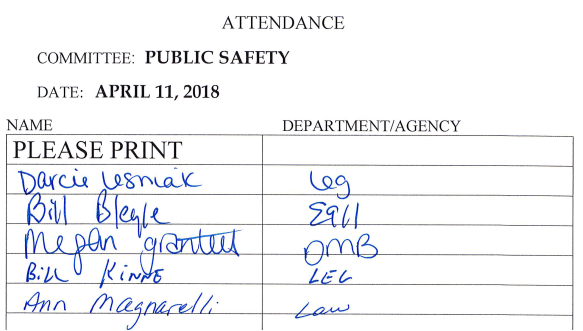
* * *
HEALTH COMMITTEE MINUTES - APRIL 12, 2018
TIMOTHY T. BURTIS, CHAIRMAN
MEMBERS PRESENT: Dr. Chase, Mr. Rowley
MEMBERS ABSENT: Ms. Williams, Ms. Cody
ALSO ATTENDING: See attached list
Chairman Burtis called the meeting to order at 9:32 a.m. A motion was made by Mr. Rowley, seconded by Dr. Chase, to waive the reading of the proceedings from the previous committee minutes. MOTION CARRIED. A motion was made by Mr. Rowley, seconded by Dr. Chase, to approve the minutes of the proceedings of the previous committee. MOTION CARRIED.
1. ONONDAGA COUNTY COMMUNITY SERVICES ADVISORY BOARD:
a. Confirming Reappointments to the Community Services Advisory Board (Timothy J. Bobo, Mary Beth Frey, James A. Yonai)
Chairman Burtis said that he appreciates what these people do.
A motion was made by Dr. Chase, seconded by Mr. Rowley, to approve this item. Passed unanimously; MOTION CARRIED.
2. Memorializing the Governor and the Legislature of the State of New York to Adopt the New York Health Act (Sponsored by Dr. Chase)
Dr. Chase said that before getting into this she would like to make a comment for the record: “I have been working on this since January - have jumped through every hoop that was told to me. Every time I went through a hoop, there was a different hoop - well that wasn’t quite right. Then the Chair gets on me because I am not doing it right, and I have been doing absolutely everything I have been told. So I am really annoyed that number one, it has taken till April to get here; and number two, that I am getting badmouthed because I don’t know what I am doing.” Chairman Burtis asked Dr. Chase when she asked to have this item put on the agenda. Dr. Chase responded, “We started this in January.” Chairman Burtis said that Dr. Chase had said that she sent this to him as a courtesy. Dr. Chase said that she was told that you work with the law department to get it together, and then it goes to Ms. Maturo to get on the agenda. It was sent to the Chair as a courtesy because he was not in the loop originally, according to what she was told. Dr. Chase referenced Mr. Holmquist and said that she too has process issues. Chairman Burtis said that there are rules to a committee and he thinks that it is pretty well understood… Dr. Chase interjected saying that she followed every rule that she was told. Chairman Burtis said that they never had a discussion about it, so in the end, he dragged it out and asked if she would like him to put it on the agenda, which is what is required. Dr. Chase questioned why he would even ask that when she had been asking since January. She said that she even wanted to ask for a waiver when this committee didn’t meet in February. She was told that she couldn’t because the new rules were such that unless something went through the committee, there would be no waivers. Chairman Burtis said that to his point, it is well understood that any form of government has rules; rules for the legislature are on the website. Dr. Chase stated that she followed the rules. Chairman Burtis said, “The chairman of any committee has the rule of the agenda, you cannot just put it out there.” Dr. Chase said that for this item she was told first to go to the law department, which she did. Ms. Magnarelli was very helpful in getting this all together. Then she was told that it went to Ms. Maturo, at which point she added the Chair to the email because she felt it was the reasonable thing to do. After further discussion Chairman Burtis stated that items are only placed on the agenda with the chairs approval, and his point is that he never received a formal request and he did not consider a cc on an email to be one.
Dr. Chase:
- Resolution follows 9 other NYS counties, which already accepted this
-
This area is very lucky to have exemplary healthcare available however, there is not always access - mainly related to insurance coverage
-
With the uncertainty of federal contributions to insurance the Assembly proposed the NY Health Act and the Senate has a matching proposal; financial resources would go into a trust that would cover insurance for all New Yorkers, besides access it would provide a $3 billion savings to the state’s healthcare cost: about $1 billion downstate, over $600 million to upstate city areas and over $1.3 billion to rural upstate areas; single-payer would provide healthcare options, which creates savings
-
1955 property taxes $140 billion, $1 million spent on Medicaid only - doesn’t include spending for those covered by government healthcare, i.e. County and City employees
-
Resolution basically states this County supports moving forward with the NY Health Act; Assembly bill has passed 3 times, Senate bill needs to be passed
Mr. Rowley questioned if the term “single-payer” meant all private insurance goes away. Dr. Chase answered that anyone can go with private insurance. However, the trust will cover the gamut of healthcare: physical health, mental health, addiction services and long-term care. Most private insurances require each item to be purchased separately. Administrative costs are reduced because single-payer is one organization, which is a big issue in the cost for services.
Mr. Rowley said that he was not prepared to vote on this today because he is not up to speed to the extent that he wants to be.
Referencing Mr. Rowley’s question regarding private insurance Chairman Burtis said that he spent a fair amount of time working on this, and the NY Health Act website states private insurance would not be offered to New Yorkers when it duplicates the service they are putting out. Mr. Rowley said that private insurance would then not be allowed. Chair Burtis stated that, the way he understands this, it would not be offered wherever this program and private insurance duplicate. The other concern is long-term care. Once passed, there is a 2 year gap for this plan to get the long-term care services it will offer up to speed, which is listed on their website. Mr. Rowley stated that this would then include long-term care. Chairman Burtis responded that it seems as if they are not prepared to have long-term care immediately - looking at a 2 year gap to get their numbers together. Mr. Rowley questioned if the term “long-term care” meant nursing home coverage. Chairman Burtis said, ”Yes - long-term insurance coverage.”
Chairman Burtis stated he was glad Dr. Chase provided some Onondaga County numbers, as far as savings - only had large number and smaller numbers are good. This item goes back to his thoughts on Obamacare, personal freedoms, liberty of choice and that type of thing. He then asked if hospitals have an opinion on this. Dr. Chase answered that there is a big contingent of both hospitals and private doctors in favor. Largely because they are currently not getting the reimbursed they need and don’t feel they will be guaranteed reimbursement down the line. St. Joseph’s Hospital is looking to name an amphitheater in order to get more advertisement. All these hospitals have big deficits, and they are always going to the state for a bailout, because they aren’t getting the reimbursement needed from the insurance companies.
-
Private health insurance will increase about 20% over the next 5 years; those covered by employers are dwindling, coverage for a family, with 4 children, is well over $1,000 per/month and the majority have between a $2,000 and $3,000 deductible
-
Dr. Chase volunteers at a clinic, the people attending are not street people - they are working people that cannot afford healthcare; those with chronic diseases put off healthcare so long that they are now in big trouble and their care cost much more than if they started early on, i.e. diabetic - start care when blood sugar is slightly elevated
-
Healthcare system only works for the wealthy or upper middle class - people cannot afford it
Chairman Burtis asked if Dr. Chase was saying that the Family Health Plus and Child Health Plus programs from the state….. Dr. Chase interjected saying that Child Health Plus has been decimated – still in the process of trying to get some money back into it. The federal funding for both programs was chopped because the federal government wants to be out of the healthcare business. NYS is still very committed to the welfare of the people but, if they cannot get this done at the state level, the county level will increase a whole lot more. Once people become acutely ill, and end up in the hospital, we will be paying for it. If there isn’t a better plan local governments will pay much more down the line.
A motion was made by Dr. Chase to approve this item. Mr. Rowley reiterated that he needs to do much more research. MOTION FAILED FOR LACK OF SECOND.
Chairman Burtis stated that unfortunately the committee is thin with Ms. Williams out due to the passing of her mother and Ms. Cody on vacation. As a point of order Mr. Rowley questioned if Dr. Chase could bring this item to the floor with a waiver, now that it has been through committee. Ms. Magnarelli stated Dr. Chase could ask for a waiver.
A motion was made by Mr. Rowley, seconded by Dr. Chase, to adjourn. MOTION CARRIED.
The meeting adjourned at 9:54 a.m.
Respectfully submitted,

KATHERINE M. FRENCH, Deputy Clerk
Onondaga County Legislature
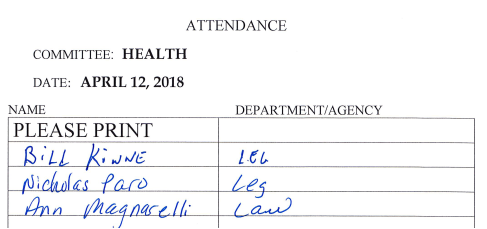
* * *
PLANNING & ECONOMIC DEVELOPMENT COMMITTEE MINUTES – APRIL 12, 2018
JOHN D. McBRIDE, CHAIRMAN
MEMBERS PRESENT: Mr. Holmquist, Mr. Burtis, *Mr. Plochocki, Mr. Buckel
ALSO ATTENDING: Chairman McMahon, Dr. Chase; see attached list
Chairman McBride called the meeting to order at 10:30 a.m. A motion was made by Mr. Burtis, seconded by Mr. Buckel to waive the reading of the minutes of the previous committee meeting; MOTION CARRIED. A motion was made by Mr. Burtis, seconded by Mr. Holmquist to approve the minutes of the previous committee meeting; MOTION CARRIED.
1. ONONDAGA CIVIC DEVELOPMENT CORPORATION:
a. Confirming Appointment and Reappointment by the Chairman of the Onondaga County Legislature to the Board of Directors of the Onondaga Civic Development Corporation (James W. Jordan, Michael LaFlair) (Sponsored by Mr. McMahon)
A motion was made by Mr. Burtis, seconded by Mr. Holmquist, to approve this item. Passed unanimously; MOTION CARRIED.
2. VISIT SYRACUSE: Danny Liedka, President
a. In Connection with the United States Bowling Congress 2018 Open Championships Tournament: Amending the 2018 County Budget to Make Surplus Room Occupancy Funding Available for use, and Providing for Agreements as may be Necessary ($150,000)
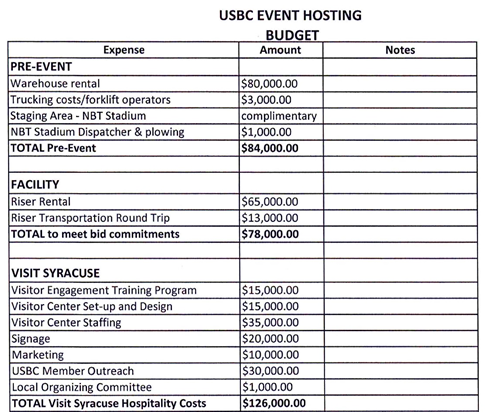

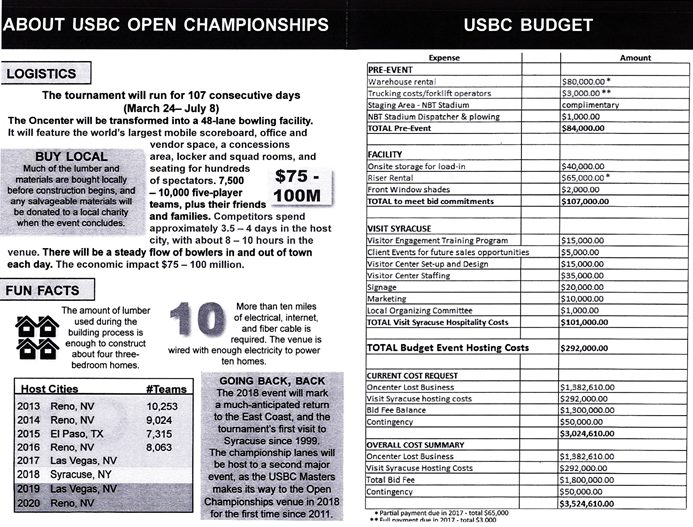
- 2013 won bid to bring USBC here; pamphlet above shows presentation to Legislature; lays out costs to host tournament
- Visit Syracuse entity pays bills; over and above budget; bills are due; paid good portion
- First page shows actual numbers - on target and under ~$4,000 of where said they would be
- Large cost – renting warehouse in Liverpool to store equipment; goes through July
- Bleacher rentals – another large number; necessary; includes rental and transportation costs
*Mr. Plochocki arrived at the meeting.
-
Training program - frontline employees at hotels, restaurants, Welcome Center; when encountering visitors, they will know what area has to offer and give recommendations
-
Visitor Center inside Oncenter staffed 9 am -9 pm to interface with bowlers, answer questions and sell area (temps)
-
Goal to keep as much spending in County as possible
-
Signage - banners, signs and window clings
-
Outreach cost – what’s on both sides of the County; what appeals to bowlers is casinos, so might lose them to casinos; implemented app and texting service to interface with bowlers while in town to entice to use County venues
-
Legislature appropriated $45,000 few months ago; outstanding balance of $243,000; $150,000 helps, but is not whole picture; realize surplus account limited; keep in mind another balance at a later date
-
At least 1 person at Visitor Center; identified peak times to have 2; making between $12 – $14/hr; staffed 9 am – 9 pm
-
Pre-Event and Facility costs are real costs; only possible fluctuating cost is staffing; everything else is real numbers that can be backed up with invoices, etc.
-
Reference contingency of $50,000 under request – took out ~$60,000 by managing items; trimmed out quite a few costs
-
39,000 - 40,000 bowlers; historically more in Vegas, but pretty good number
-
Hotels doing well in City and suburbs; creates compression in market, which drives rates - ROT up, sales tax up
-
Transportation – fortunate that men compared to women (bowlers) rent cars; plus there is Uber and Lift here now (did not have when women’s tournament was here); before required shuttling
-
Biggest obstacle trying to attract new business – may take up to 3 hotels to accommodate function at Convention Center; need transports; spending $125,000/year on transportation
-
Transportation comes from Visit Syracuse general operating; services line in budget - spent over $100,000 in transportation; between Crown Plaza and Sheraton to Convention Center; have to factor in to be competitive
A motion was made by Mr. Buckel, seconded by Mr. Plochocki, to approve this item. Passed unanimously; MOTION CARRIED.
b. Designating Visit Syracuse as the Agency Authorized to make Application to the New York State Department of Economic Development and to Receive Matching Funds Therefrom Under The New York State Tourist Promotion Act For 2018
- Governor’s budget stable and going up for 2018; money through “I love NY”; every county different
-
Visit Syracuse puts up $68,000 for marketing efforts tagged with “I Love NY”, and state matches $68,000
-
Money this year used for website and photography on website; not visually stimulating to visitor
-
Push forward with great photography, and tag “I love NY” to get money; cover twice as much ground for half price
-
State number is formula by county; believe it’s based on ROT collections, hotels in market & operating budget for CVB
-
Would be shocked if any county did not do this; anyone can identify things to move forward and meet their criteria
-
Photography costs about $60,000; can reallocate match to other things
-
Think Legislature will be pleased with where Visit Syracuse is going; marketed last year as winter only destination, but that’s not Mr. Liedka’s point of view; 4 great seasons, so that’s how it will be marketed
A motion was made by Mr. Holmquist, seconded by Mr. Plochocki, to approve this item. Passed unanimously; MOTION CARRIED.
3. SYRACUSE ONONDAGA COUNTY PLANNING AGENCY: Don Jordan, Deputy Director
a. Calling for a Public Hearing for Renewal of Agricultural District No. 1, Towns of Lafayette, Onondaga, Otisco, and Tully
-
NYS passed Ag Districts Law in early 70’s to help keep farmland in ag production; ag districts designed to discourage farmland being turned to non-ag uses
-
County has 4: Dist. 1 South, Central; Dist. 2 South, West; Dist. 3 North; Dist. 4 South, East
-
Ag Districts Law requires the districts be renewed, reviewed and recertified every 8 years
-
Dist. 1 review this year: mailing to landowners with property in district; have option to add or remove land
-
8 year review is the only time landowners can request to have land removed from district
-
There is an annual process for landowners to add property to a district
-
Received requests for removals and additions as seen in the resolution
-
Farmland Protection Board reviewed requests; recommending continuing district with modifications; increase 305 acres
-
Review requires public hearing; resolution calls for the public hearing for review of District 1 – will be held prior to June session; will come back next month with resolution approving changes to be considered for June Session
-
Landowners remove land if property not being used for ag (at one time it did); also when districts were formed they were contiguous lands that may not have been farmed; ownership changes, and land use changes
-
Towns will be notified of public hearing and will see changes; they have not yet weighed in
-
Towns notified of process (8 year review) up front; given lists of additions and removals with notice of public hearing
-
Only once every 8 years during district review can land can be taken out; District 2 will be reviewed in 2 years; landowners in District 2 will be able to remove or add land during that time
-
Every year there is ag activity because of additions, but every other year is a full 8 year review
A motion was made by Mr. Burtis, seconded by Mr. Plochocki, to approve this item. Passed unanimously; MOTION CARRIED.
b. Calling for a Public Hearing on the Proposed Inclusion of Viable Agricultural Lands within Certified Agricultural Districts Pursuant to Section 303-B of the New York State Agriculture and Markets Law
- Each year January 1st – 30th landowners can add land to districts; this year there are 9 properties in 2 districts
-
Farmland Protection Board reviewed requests, and recommends 8 properties be added
-
Requires public hearing prior to June session; resolution next month to approve of the changes
-
Tax break - Ag Districts Law created ag assessment, but do not need to be in ag district; have to meet eligibility criteria
-
Benefit to ag district - Right to Farm protections; farm abides by general accepted practices; gives farm protections against complaints of farm nuisances
A motion was made by Mr. Buckel, seconded by Mr. Plochocki, to approve this item. Passed unanimously; MOTION CARRIED.
4. GREATER SYRACUSE: Katelyn Wright, Executive Director; James Corbett, Vice Chair, Board of Directors
a. Annual Report
Ms. Wright:
- Local public authority est. by City and County to take vacant/abandoned properties, and bring them to productive use
- State Land Bank Act requires briefing to the Legislative body each year, including answering any questions
-
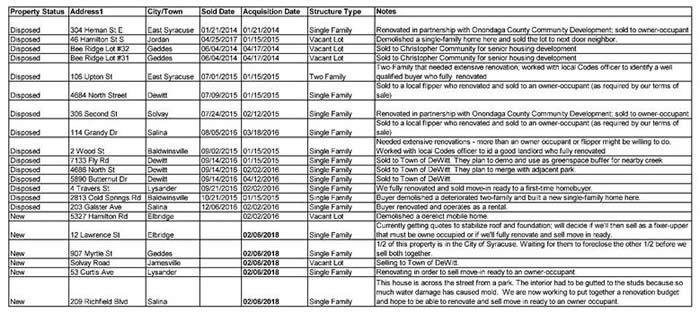 Most work in City, but have done work in towns and villages; table shows all property acquired to date outside the City, and what’s become of them
Most work in City, but have done work in towns and villages; table shows all property acquired to date outside the City, and what’s become of them
-
Each year work with Village Mayors, Town Supervisors, and Code Enforcement Officials - go over auction list; ask if there are properties better suited for Land Bank
-
Most prefer certain houses go to Land Bank; when Land Bank lists for sale, they can put specific terms and restrictions on what the buyers can do with them; more predictability from Land Bank versus auction
-
Town of Salina had hoarder house; tried to sell at auction, but person did not want it; spent ~$7,000 to clean out; once gutted, had potential
-
Vet buyers to ensure they have experience and financing necessary for project; once sold, buyer has 12 months to finish whatever the redevelopment plan is; Salina house listed with requirement that it must become owner occupied
-
Able to make residence, or flip; (Salina house) flipper did nice job and sold for close to $120,000; second transaction with flipper helps comps in area (sold to flipper for around $25,000)
-
Owner occupant nice outcome, but low sales price as they will put money into rehab
-
Village of Jordan - Mayor does not want to demolish home; finding homes neglected for many years prior to foreclosure
-
All 4 foundation walls compromised and roof leaking; might spend $60,000 - $70,000 to fix; hope to then sell shell for $10,000; buyer would put in ~$80,000 for rehab; homes in village not worth making investment
Mr. Corbett:
-
Dealt with Ken Bush out there; make such difference doing 1 or 2 homes - impacts whole area vs. City for 1 or 2 blocks
-
Done 3 or 4 in village; County has auctions – trying to think of new ways to exist, because of financial constraints
-
Hypothetically work with County, and able to get into business of the Land Bank doing auction houses; do revenue sharing with County; take a lot of things off the hands of County
Mr. Buckel clarified that the County identifies the tax delinquent properties in the towns, then does the foreclosure process and auction. Mr. Corbett and Ms. Wright agreed. Mr. Buckel said they want to possibly have the Land Bank step in the County’s shoes. Ms. Wright commented:
-
There are arrays of models across state; some say instead of auction, foreclose and convey to the Land Bank; Land Bank would then list properties for sale
-
i.e. Auction process did not work for house on Brandy in Town of Salina, because people did not know what they were getting into; sight unseen; full of trash; Land Bank sells for $25,000, which is more than garnered via auction
-
Opportunity to generate more sales, and split revenue with County; Land Bank would use money to cover costs of cleanouts and managing properties
-
Not suggesting any change to current foreclosure laws; right now owners are entitled to certain notifications; takes 2 – 3 years to foreclose on a property; would not suggest changing that
Mr. Buckel might suggest a change if the property is tax delinquent for a certain amount of time as long as due process is given. Mr. Corbett said there are many properties out there that are abandoned, but the taxes are paid. Mr. Corbett said they’ve spoken to towns and villages, and asked if there’s a Home Rule where they can come in and condemn it.
Ms. Wright:
- Met with Mayor of N. Syracuse - gave 20 problem properties in village; only 2 to auction, because others paying taxes
-
There are mechanisms to go after the properties like citing for code violations
-
Issue is across County all towns and villages have their own Code Enforcement Offices and 1 attorney that does all municipality work; cannot develop expertise in code enforcement
-
Wonder if County can provide a circuit attorney to offer services to towns and villages with Code Enforcement expertise to push for more accountability from property owners
-
Could try to go after these properties with abandonment proceeding, even when paying taxes; if town has to mow the lawn or board up the windows, they can argue the property is abandoned, and try to get the title
- Used funds in past to purchase abandoned properties if there is an owner willing to let go
Mr. Burtis commented that there is a piece of property in his district that was lost during the credit crisis, the title is gone, and the owner is paying the taxes; but it is an eye sore. Mr. Burtis agreed with Mr. Corbett that it is a “zombie property.” In Cicero this is a serious concern, because the properties are rotting. The town is mowing the lawn, possibly treating the green pool (with misquotes around), and the neighbors are only a little happy.
Ms. Wright:
-
Abandonment Law is on the books, but 2 challenges: 1 - towns and villages do not have expertise to use it; 2 – process to notify property owners is cumbersome
-
There is proposed legislation at state level that could make it easier to notify owners, and move through courts; will get; bill numbers and send to everyone; County could help advocate for it
-
Huge back log of abandoned properties that were neglected for long time, and snowballed; City under previous administration sending out foreclosure notices to catch up
-
Thought it would be 3 year process; catch up and under control with only certain properties being seized each year
-
At it for 5 years and not fully implemented; new administration made commitment to speeding up process; want to get caught up, and get to process where once a year properties are seizable
-
Holding property owners accountable increased rate of delinquent tax collection in City, which also helps County; doing better tax collection means more money to County from City
-
1st obstacle – higher rate of demos with properties coming to Land Bank; raising funds to catch up is an undertaking
-
Received grants from State Attorney General’s office; County has provided funding over past few years
-
Looking at ~$4.5 - $5 million to catch up on demoing homes already owned; plus several 100 more not foreclosed yet
-
As demos happen, excited to create space for new development; once get 3 or 4 lots in a row, can see what is possible; list those with private developers to get construction happening
-
2nd obstacle – structural operating deficit; providing service private sector will not provide
-
5 or 6 seizable properties with tax liens; need City to do foreclosure process, so Land Bank can consolidate them under one owner, clean them up and make marketable; but service costs more than return (why private sector not doing)
-
It does generate return with property values, and getting back on tax rolls; generates more money for City and County
-
Land Bank cannot capture that revenue; only get small sales revenue off lot when done; not enough to cover costs of providing this public service; looking for ways to bridge operating deficit
-
Last year $1.5 million in sales, but costs $2.2 million to run Land Bank
-
Deconstruction - to disassemble house and capture materials each demo costs 2-3x the cost of normal demo; did pilot program previously with 6 houses; spent extra $200,000 over normal demo, and sold materials for $40,000
Mr. Corbett said if a contractor has six houses, then they go for the low hanging fruit like oak banisters. Most houses have lead paint, lead windows, or asbestos. It is labor intensive and drives up the costs. Through the state, they are looking at a mortgage tax. Ms. Wright said either a Mortgage Reporting Tax or a Real Property Transfer Tax. Mr. Corbett said this is to become financially independent, so the Land Bank does not have to come back to City or County government.
Ms. Wright:
-
Looked at Land Banks across the nation; Ohio only state model that funds Land Bank long term; increased interest rate on delinquent property taxes from 3% to 8%; extra revenue funds Land Bank
-
In Cuyahoga County where Cleveland is, it brings in $7 - $8 million/year for demos and operating deficits
-
Cannot do that here; already at 12%; looking at models to emulate – small increase to Mortgage Reporting Tax or Real Property Transfer Tax; told not to bother trying in 2018 being an election year
-
Analyzing costs to family at time sell and buy; looking to be couple $100 added to transaction costs; average family does once every 10 years
-
Impact on average household low, but would generate revenue for Land Bank - would not have to come to Legislature for allocations, and can be more active in towns and villages by putting pot of money together for purchasing
Mr. Corbett said one suggestion is to have both the County Legislature and Common Council of Syracuse to send letters to the Governor’s office about a Home Rule.
Chairman McMahon:
-
Issue mentioned previously was the previous administration dumping inventory onto the Land Bank; Land Bank at a point that they cannot handle the inventory
-
Is Ms. Wright working with the new administration on only taking on inventory that has strategic purposes (i.e. clustering)? If not, would recommend it
-
Looking from outside, and understanding how City works, City took their problem, and made it the Land Bank’s problem
- From Board standpoint, until get a grasp on this, the Land Bank should be more selective on what they take on
Mr. Corbett reassured Chairman McMahon that they are being more selective.
Ms. Wright:
- Common Council voted to remove Land Bank funding from budget last May; Land Bank stopped taking demo candidates
-
Trying to fast track properties that are strategic for site assemblage; even if not priority for site assemblage, still picking almost every tax foreclosure coming their way; exceptions are demo candidates and potential brown fields (liability)
-
Properties already abandoned; 1,000 vacant lots and 2,000 buildings owners walked away from; not mowing lawns or boarding up; if owner not doing, becomes City’s responsibility
-
Costs City $54 to mow a lawn, costs Land Bank $12; costs City $200 to board up windows, costs Land Bank $30
-
If public has to play role in maintaining properties, than let Land Bank do cheaper - but City has to pay for
-
Share same goal of finding mechanism to pay for services that need to be provided
-
23 Land Banks across the state in lobbying effort to get things changed; not sure it can be changed at state level, but maybe Onondaga County could be a front runner to pilot this under Home Rule vs. statewide
Chairman McMahon:
Ms. Wright stated if it’s a Home Rule, then the County would have to get the state’s permission, because the Mortgage Reporting Tax is a state fee. The state would grant Onondaga County permission to do it. Chairman McMahon thinks they would have a hard time passing it. He believes they have the right idea, but wrong bucket. Ms. Wright believes it would. Erie County has done the same thing with Real Property Transfer Tax, and they have asked for multiple increases each year for their county (vs. state).
Mr. Corbett:
-
Good point of discussion; shows the Land Bank is trying to do whatever possible to be financially stable, and continue the good work that has happened
-
Good rapport with new Mayor; appears that some new Common Councilors are listening to their constituents, and what good has been done
-
Left council meeting asking if they were better off before the Land Bank, or after it
Chairman McMahon stated the City has a stronger moral obligation to deal with by dumping properties onto the Land Bank, then cutting off their funding stream. Ms. Wright asked about the $5 fee per house. Chairman McMahon responded that anytime anything is needed at the state level with varying degrees of interest, it’s a longer process. Ms. Wright asked if the $5 fee does not need state approval. Chairman McMahon is not sure if it would. Local people would see the benefit of a small surcharge that they probably would never feel.
Mr. Corbett said there has been so much work done in the City, and they try to make sure that the appropriate amount is done in the County. The Land Bank’s hands are tied on how to get those properties. Chairman McMahon said every year there are ones through the auction, and it’s easier to cluster those in villages. There has been success in Jordan and Baldwinsville. The Land Bank has had success in suburban areas, but there is a larger problem in the City.
Mr. Buckel shares Chairman McMahon’s view that anytime the County can control their own destiny it is better. Waiting for the state to act is complex. Mr. Buckel suggested looking into the existing Home Rule for a revenue source, and if there is, through the County Attorney’s standpoint, then it would solve City and County revenue issues. They would love to see a stable funding source that may also be delegated to the abandonment process. Ms. Wright agreed. Ms. Wright was not aware there would be a way to do it without state permission, and will research that.
Mr. Corbett has been on the Region 7 Fish and Wildlife Board for 22 years, and he is the full time recording secretary. There has not been a landowner representative for 7 – 10 years, and said it would be a voice to those who hunt and fish. Mr. Corbett said the landowner has to have over 50 acres. Chairman McMahon wanted clarification that Onondaga County has a vacant spot on the board for a landowner, and Mr. Corbett agreed. Chairman McMahon believes it’s a recommendation from the Executive, and the Legislature approves it. Chairman McMahon asked Jamie (McNamara) to research it, and find out how it happens.
Mr. Corbett and Ms. Wright appreciate the committee’s time and suggestions.
Chairman McMahon believes the Butternut Commons grand opening is today, and the Legislature helped the Land Bank cluster the properties to become new development. It takes time, but it works.
The meeting was adjourned at 11:25 a.m.
Respectfully submitted,

JAMIE McNAMARA, Assistant Clerk
Onondaga County Legislature
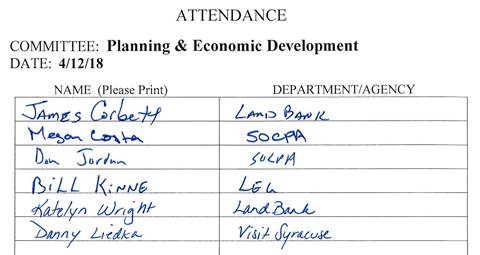
* * *
WAYS AND MEANS COMMITTEE MINUTES - APRIL 20, 2018
BRIAN MAY, CHAIRMAN
MEMBERS PRESENT: Mr. Jordan, Mr. Knapp, Mr. Plochocki, Mr. Ryan, Ervin
MEMBERS ABSENT: Ms. Williams
ALSO PRESENT: Chairman McMahon, Mr. Bush, Mr. Rowley, see also attached list
Chairman May called the meeting to order at 9:12 a.m.
Chairman May stated for the record: “It’s all about transparency and respecting open meetings law here. That’s very important and everyone is invited. The more the merrier, including the media. Pointing to a cell phone camera being operated by Arthur Karpinski, an employee of the Water Environment Protection Department, Chairman May stated “that camera right there, however, is not kind of in the spirit of that process. He asked Mr. Karpinski to make sure that it does not become a distraction in any way to the meeting.
A motion was made by Mr. Knapp, seconded by Mr. Jordan, to waive the reading of the minutes of the proceedings of the previous committee. MOTION CARRIED. A motion was made by Mrs. Ervin, seconded by Mr. Knapp, to approve the minutes of the proceedings of the previous committee. MOTION CARRIED.
1. ONONDAGA COMMUNITY COLLEGE:
a. Calling for a Public Hearing on the Tentative 2018–2019 Budget of the Onondaga Community College
- Ways & Means Committee public hearing, May 21st at 9:00 a.m.
A motion was made by Mr. Knapp, seconded by Mrs. Ervin, to approve this item. Passed unanimously; MOTION CARRIED.
2. FINANCE: Donald Weber, Director, Real Property Tax Services
a. Approving and Directing the Correction of Certain Errors on Tax Bills
- Four 2018 tax bills which resulted in corrections greater than $2,500 – require legislative approval
- 1st was Onondaga county property; 2nd was for an industrial water use; the last two were court ordered corrections to the assessments
In answer to Chairman May, Mr. Weber said that the 2nd property was Cintas, a uniform company, which sold the building to a new owner.
A motion was mad by Mr. Knapp, seconded by Mrs. Ervin, to approve this item. Passed unanimously; MOTION CARRIED.
3. CNY ARTS: Stephen Butler, Executive Director
a. Amending the 2018 County Budget to Make Funds Available to CNY Arts ($125,000)
- On behalf of arts and cultural agencies that have applied for economic development funds
- Have met with County Facilities Committee, a list of projects has been provided
- Requesting funds to be released from contingency
A motion was made by Mr. Knapp, seconded by Mrs. Ervin, to approve this item. Passed unanimously; MOTION CARRIED.
4. ONCENTER/WAR MEMORIAL: William Fisher, Deputy County Executive
a. Amending the 2018 County Budget to Provide for Improvements at the Oncenter in Connection with Grant Funds from the Empire State Development Corporation’s Market NY Grant Program, and Authorizing the Execution of Agreements ($975,000)
- Grants accepted in August 2017
- Was accepted into a budget that ended with the fiscal year
-
About to have a grant disbursement; Oncenter is ready to procure equipment, furniture, fixtures, but money can’t actually be spent because the appropriations went into a budget that expired
- Resolution allows appropriating the money into a capital project where in can be spent by Oncenter for the same purpose described last fall
- This is a correction of an error
Mr. Knapp said that this is simply moving it from one budget line into another budget line. Mr. Fisher agreed.
Mr. Rowley asked if the cash is in hand. Mr. Morgan said “no”. Mr. Rowley asked if it is a reimbursement grant; Mr. Fisher answered that it is.
A motion was made by Mr. Knapp, seconded by Mr. Ryan, to approve this item. Passed unanimously; MOTION CARRIED
5. VISIT SYRACUSE: William Fisher, Deputy County Executive
a. In Connection with the United States Bowling Congress 2018 Open Championships Tournament: Amending the 2018 County Budget to Make Surplus Room Occupancy Funding Available for use, and Providing for Agreements as May be Necessary ($150,000)
Mr. Fisher:
-
Legislature appropriated $45,000 last fall from a contingency account; this would come from surplus room occupancy tax
-
Mr. Liedka, President, Visit Syracuse, has presented an updated version of extraordinary expenses on Visit Syracuse due to bowling conference – in excess of $150,000
-
A variety of things had to be done by Visit Syracuse – storing, providing visitor information centers, etc.
-
Legislature’s will to give $150,000 now and ask them to tighten their belts; if more money is needed there may be further appropriation needing to be approved by July 8th
Chairman McMahon:
-
There is about $280,000 in hard costs associated with preparation of hosting the bowling convention that Visit Syracuse has, which is outside of their normal budget appropriation
-
$3.6 million was allocated to get the event here – knew at that time there would be a hard cost for storage space, having staff on site
-
$45,000 appropriated last year and this $150,000 does not meet the total number that Visit Syracuse has asked for
- He asked Mr. Liedka to see what can be done with their own budget before coming back – waiting until the event is over so they can reconcile what the actual cost was
Chairman May said that at County Facilities Committee, Mr. Knapp asked for a ROT update to be given at Ways & Means to have some perspective on it – i.e. if there are more expenses, where are they going to come from and to what extent can ROT support that.
Mr. Knapp asked where the funds came from to build the lanes, etc. Mr. Fisher said that the bid fee was $1.5 million, which was appropriated in 2012; it was prepaid. Mr. Knapp asked about transportation. Chairman McMahon said that it is all part of this number. He said that one of the complaints that we have, when there are big conventions, is that there isn’t really organized transportation from the hotels to the venue. That is one of the services that Visit Syracuse is providing. He noted that there is still some surplus ROT money, but chose not to attack that – see if Visit Syracuse has some room in their budget to absorb a little bit more of it.
Chairman May questioned if there is an opportunity for advertising and sponsorship for some of the activities across the venue. He asked Mr. Fisher if he knows if they are doing anything with that. Chairman May said that every piece of signage, every piece of paper that guides people to their next step in the process could be an advertising opportunity or sponsorship. Mr. Fisher said that there is a very detailed RFP, which made very clear what rights they have. In general, they (U.S. Bowlers) build a lot of stuff and build merchandising opportunities we retain some food and beverage opportunities and some opportunities to bring local vendors to the attention of bowlers. There was some opportunity to help defray some of the expense of that – in general we weren’t looking to get local vendors to pay us so that they could sell to bowlers. Chairman McMahon said that US Bowling had that in their wheelhouse – it was their rights for the event. Once we saw that their sponsors were more national brand sponsors who help bowling and did very little for community, we felt there was a missed opportunity with trying to team up with some of the local businesses that could really benefit Visit Syracuse’s team strategy. There won’t be a large sponsor coming with $25,000, but it could really generate some revenue with the restaurants, etc. He encouraged all to go over and look at the set up – it is very impressive and we won’t have another one like his here for 8 – 9 years.
Chairman McMahon noted that the hotels that have engaged Visit Syracuse have done very well. ROT might increase a little bit, but ROT has gone down a little bit due to the surplus of hotel rooms in the market. Mr. Fisher added that the first part of the conference was mostly professionals, but beginning this week there is bowling from 7:00 a.m. until 3:00 a.m.; 48 lanes filled with people that aren’t from here – staying in hotels and spending money. Some of the suburban hotels have been very aggressive with pricing and have done very well. Chairman McMahon said that he knows that the Carrier Circle folks have done very well.
Mrs. Ervin said that they are going to Turning Stone as well; Chairman McMahon noted that they are a big sponsor.
Mr. Jordan said that some of the costs seemed awfully high, i.e. $80,000 for warehouse rental – is sure there is a lot of stuff, but it seems high for a short-term rental. He questioned the Visitor Engagement Training Program, $15,000 – was not sure what that is. It seems there would be opportunities to cut cost. Chairman McMahon said that is why they weren’t given the whole ask. Chairman May said that he is not qualified to say what a forklift is going to cost for an event, or a warehouse rental cost. He saw a couple of spots where there may be an opportunity, but is sure that they own those rights.
A motion was made by Mr. Knapp, seconded by Mrs. Ervin, to approve this item. Passed unanimously; MOTION CARRIED.
6. EMERGENCY COMMUNICATIONS: William Bleyle, Commissioner
a. Amending the 2018 County Budget to Accept Funds from the New York State Department of Homeland Security and Emergency Services’ Public Safety Answering Point (PSAP) Grant Program, and Authorizing the Execution of Contracts ($177,652)
-
Grant allocated for specific initiatives – includes regional implementation, implementation of Next Generation 911, improve interoperability of public safety communications, developing multi-jurisdictions compatibility as well as improving the safety of the public
-
Initiate Automated Secure Alarm Protocol (ASAP):
- Currently if you have an alarm in home or business, that alarm comes into a 3rd party monitoring center.
- People at monitoring center enter it into their system and make a phone call to 911 Center
- 911 Center call takers receive information and enter it into county’s computer aided dispatch system and then send it to the appropriate dispatcher (fire, police, EMS or a combination of)
- ASAP allows a computer system to computer system interface – when an alarm comes into an alarm company, they will enter it into their CAD system, and it will automatically enter into county’s CAD system and go right to appropriate dispatcher
- Will allow processing of alarm calls a lot quicker; where implemented estimates are that it shaves about 2 minutes off an alarm
- Will eliminate phone calls to them – most alarm calls are during thunderstorms, heavy wind storms –where power goes out. People’s batteries are not well maintained in their home alarm systems some times and end up sending out accidental alarms
- Advantageous to public safety and 911 Center – would cut down during peak alarm periods and may not have to staff up to the same levels during anticipated storms
- For each alarm, approximately 3 calls are received: a call reporting the alarm, a call telling who is going to respond; call back to alarm company to let them know how the alarm turned out – won’t have to make any of those calls with participating alarm companie
- Text to 911 Interface Improvements:
-
Currently text to 911 messages are answered, but are done on web-based interface, which is not as well supported as it used to be – company seems to be getting out of the business
-
Being a web-based interface, have to take information off of web page and manually enter into our systems. Going back and forth adds time to processing calls
-
Typically a voice call is processed in a little over a minute; when it comes to text to 911 messages with the back and forth, it can take up to 14 minutes to process them
-
Looking to interface it directly into call taking system – will appear just like a phone call and that information will automatically integrate with dispatch with computer dispatch system
-
Should allow for increased reliability and increase the ability to process the call quicker
-
Text to 911 messages are heavily relied upon by the hearing and speech impaired community – primary accessibility method for some and want to make sure that we have an efficient, reliable system in place
In answer to Mr. Knapp, Mr. Bleyle confirmed that there is no local match or local dollars.
Chairman May asked what percent of this is the text to 911. Mr. Bleyle said that he did not have those figures with him. The biggest piece is the Alarm Secured Automated Protocol interface because there are a number of steps – have to update CAD system to accept it, have to do a lot of testing, and have to ensure reliability.
A motion was made by Mr. Jordan, seconded by Mr. Knapp, to approve this item. Passed unanimously; MOTION CARRIED.
b. Amending the 2018 County Budget to Accept Funds from the New York State 2017 Statewide Interoperable Communications Grant Program, and Authorizing the Execution of Contracts ($1,360,003)
-
Grant from NYS Dept. of Homeland Security and Emergency Services – comes from some of the surcharge money that that state has been accepting for wireless phones – grant allocated specifically to improve interoperable emergency communications
-
For a number of years on capital improvement plan there has been a request to update the back up site system of trunked radio system
-
System provides radio service for more than 150 public safety and public service agencies in Onondaga County – over 8,500 radios with the county attached to the system
-
Need to ensure continuous reliability of the system
-
Looking to have a geo-redundant back up
-
Currently most all of the computer systems have some degree of geo-redundancy – if there were to be a main failure in the 911 Center, even though there is a backup site, those computers would continue to operate in other locations
-
Grant will allow having a geo-redundant back up for radio system and eliminate a capital project that is currently on the table – would pay the entire amount of that project
Mr. Knapp said that this was going to have to be local dollars that would have to be spent at some point. Mr. Bleyle said that he would have to come to the legislature requesting bonding. Mr. Knapp said that this is great news and thanked Mr. Bleyle for getting it.
In answer to Chairman May, Mr. Bleyle said that there are no matching funds.
Mr. Jordan made a motion to approve this item.
Mr. Rowley asked about the cash piece and if it was reimbursable. Mr. Bleyle said that it is reimbursable – as they go through the different stages, will submit a request for reimbursement quarterly.
Chairman May asked where this puts us in terms of the cutting edge. Mr. Bleyle said that most counties have systems like ours. It is a fairly new technology, but many of our neighboring counties have moved in the direction of doing this. We have a shared radio system master site – he thinks this puts us where we need to be to ensure the reliability of our system. In many ways, it is new technology and we are moving forward with the technology, but it is also saving the need to find redundancies in other areas. He said that we definitely need to ensure the reliability of our system in the event there was a failure.
Mr. Ryan seconded the motion to approve this item. Passed unanimously; MOTION CARRIED.
7. TRANSPORTATION: Martin Voss, Commissioner
a. A Resolution Authorizing the Reconstruction of County Roads in and for the County of Onondaga, New York, at a Maximum Estimated Cost of $5,700,000, and Authorizing the Issuance of $5,700,000 Bonds of said County to Pay Costs Thereof ($5,700,000)
Mr. Voss presented the 2018 Work Plan:
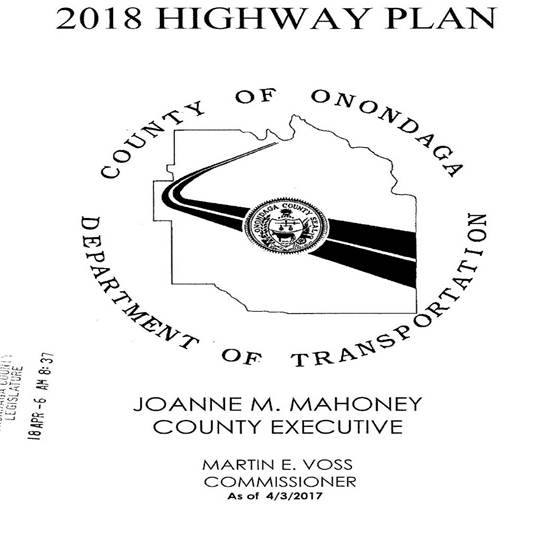
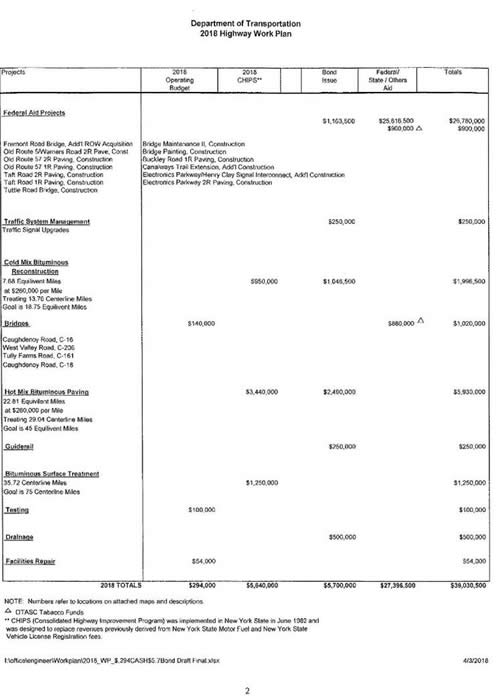 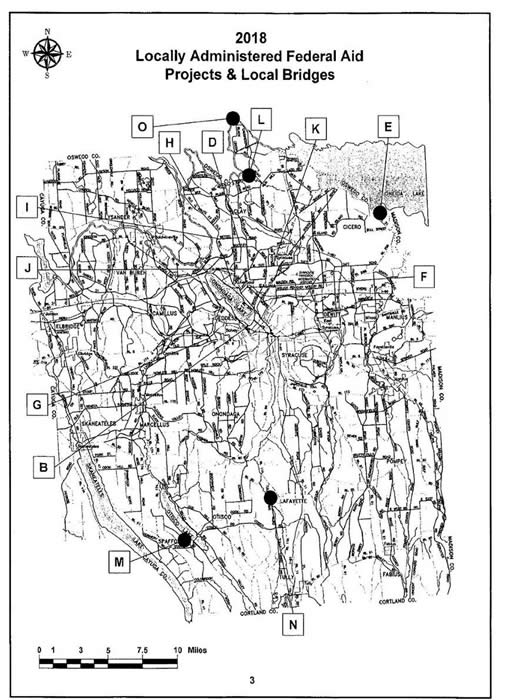
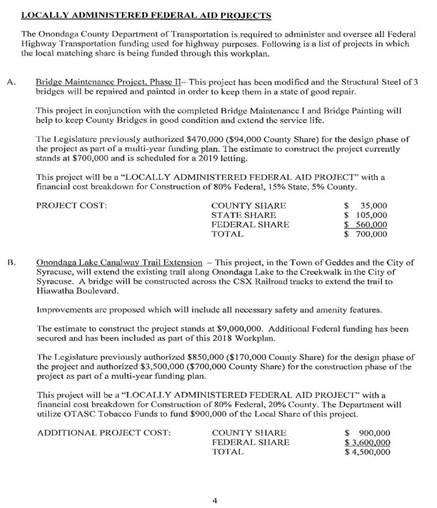 
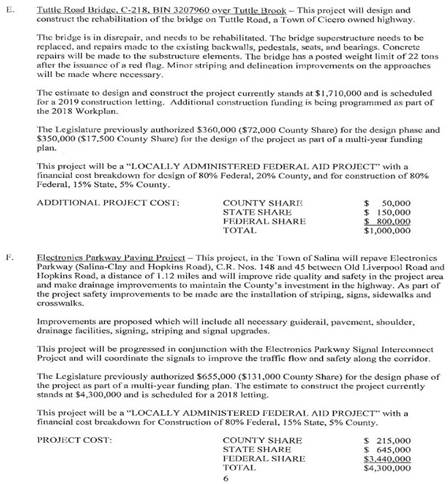 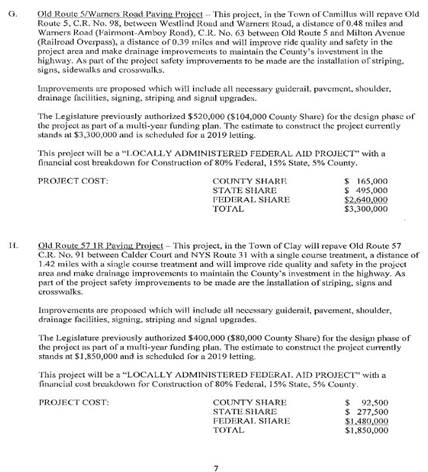
 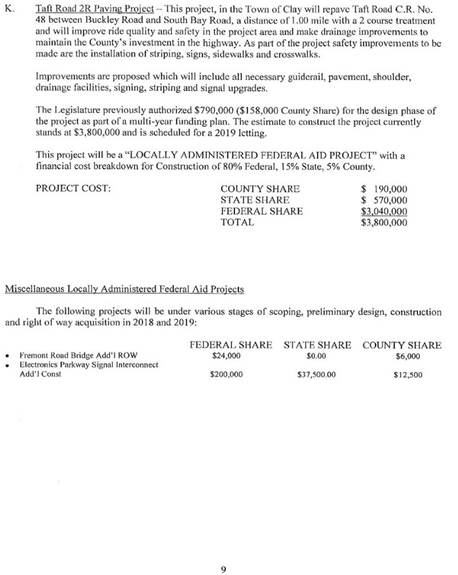
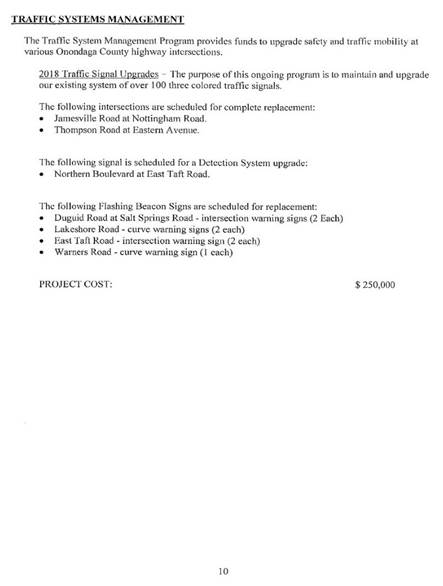 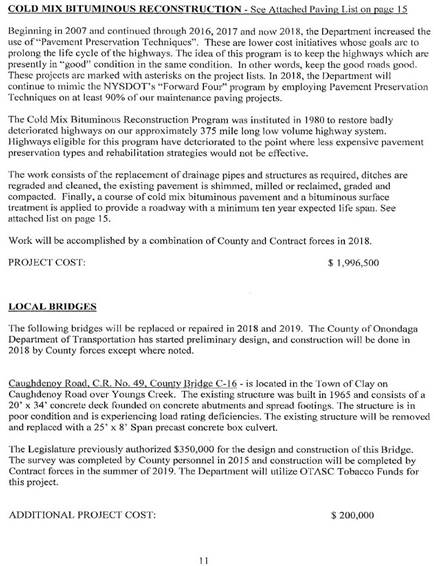
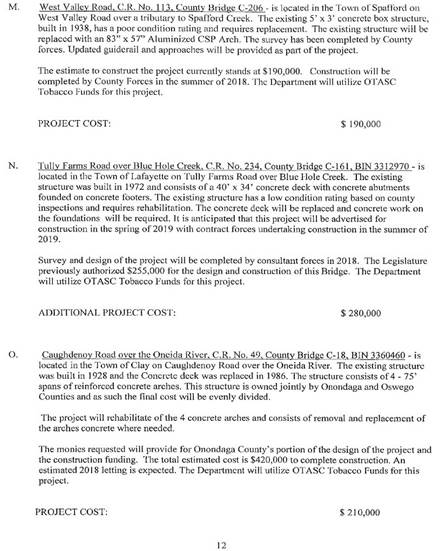 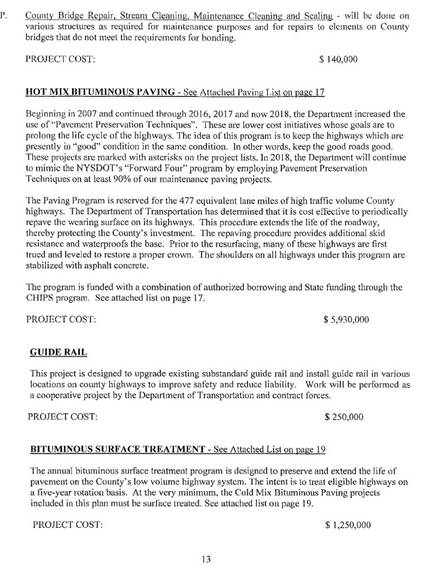
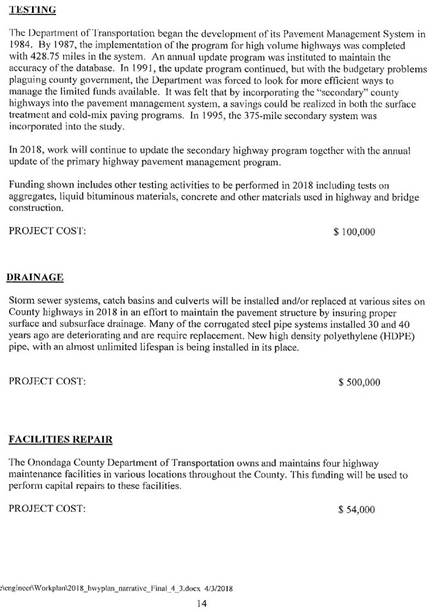 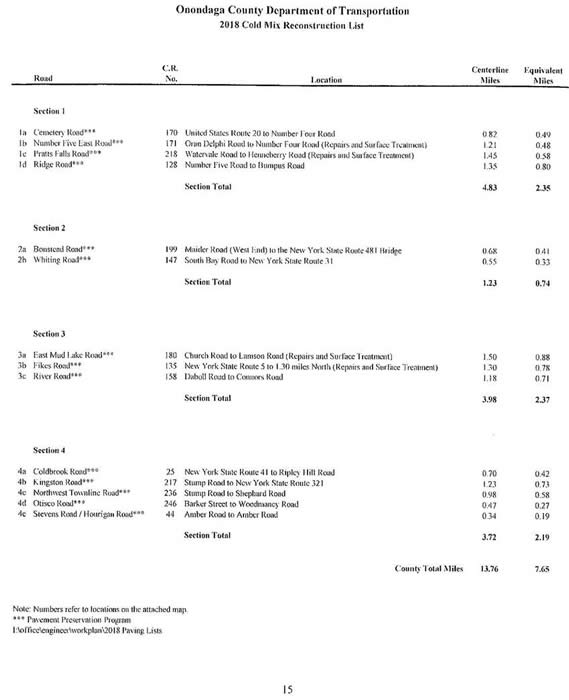
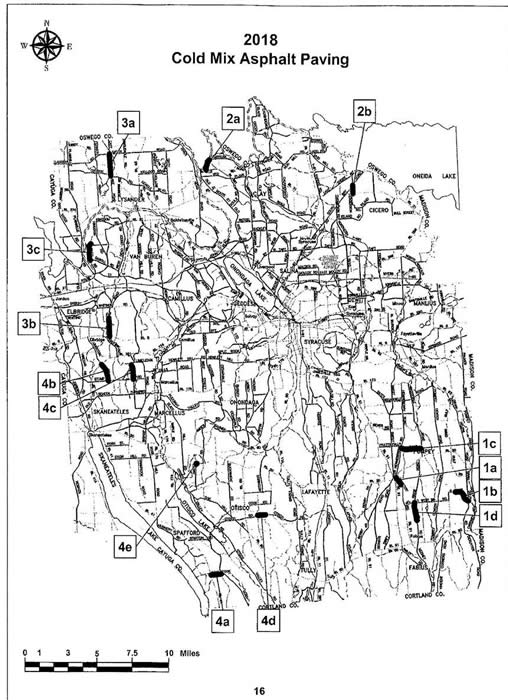 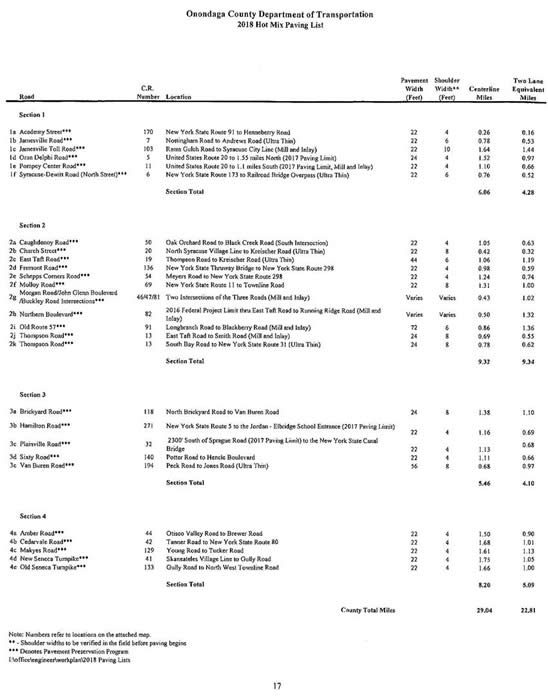
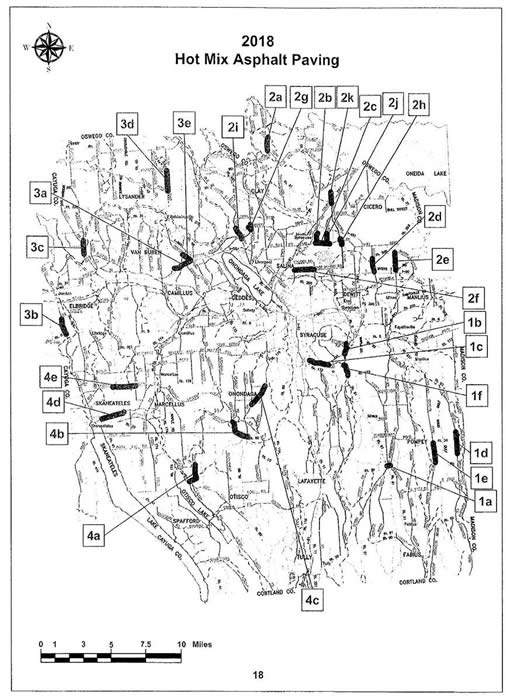 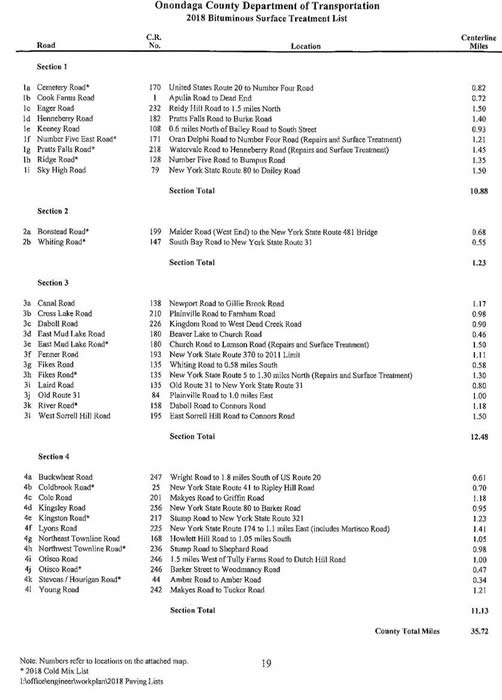
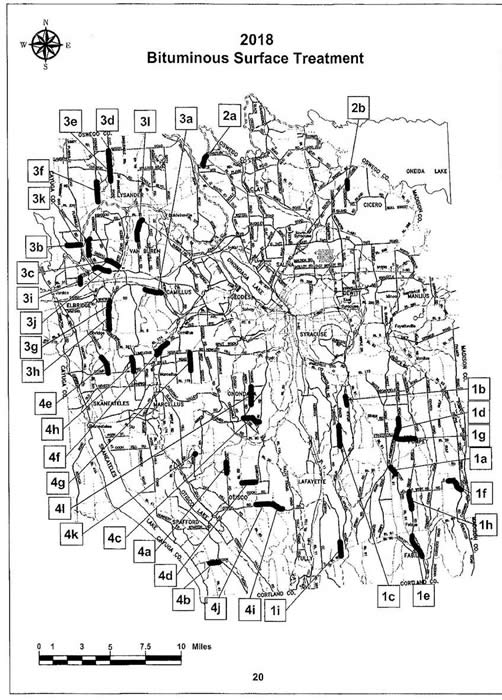
-
Last year started out with an operating budget of $1.394 million in cash; there was a mid-year cut of $1 million; during budget last year it went down to $294,000 cash, which has had an impact on the department’s ability to fund these things as we go
-
CHIPS budgeted at same number in 2017, $5,640,000; no official number yet – will bring a separate resolution if it is different or if additional funding comes in from the state
-
Bond issue represents $4.6 million borrowed last year plus the $1.1 million that was cut from cash
-
Leverages $27,396,500 in federal, state, and other funding
-
Other funding is the tobacco settlement cash approved last year for a 2-year capital plan for bridges
-
$39,030,500 – total for work this year
Mr. Voss reviewed the federal aid projects listed in the plan, pg. 4. He said that they are big ticket, multi-year, multi-phase, design, bidding and construction projects that take a couple of years to get moving. They are all federal and state funded.
- Miscellaneous locally administer federal aid project, pg. 9, are continuing federal aid projects of a smaller magnitude.
- Traffic Systems Management, pg. 10, was kept steady from last year
- Cold Mix – projects list on pg. 15
Mr. Voss reviewed the Local Bridges projects, lists on pages 11 – 13
- Hot Mix – project listed on page 12
- Guide Rail – consistent with last year
-
Bituminous Surface Treatment – final surface coat over cold mix; cold mix applied to lower volume roads; if able to do just bituminous and do just a pavement preservation to keep it drivable and safe, then they will do that. If they can’t, it will get cold mix and bituminous. He noted that everything that gets cold mix, also gets bituminous; but not everything that gets bituminous also gets cold mix
-
Testing – every 4 years every highway garage section gets county roads evaluated by the vendor, currently Stantec. They use equipment to provide a baseline rating for each of the roads, which drives the development of the work plan
-
Try to maximize as much federal and state aid as possible
Chairman McMahon thanked Mr. Voss for his work in putting the plan together. He referred to Mr. Voss’s comments about cuts the legislature made and also referenced that the legislature made cuts to a legislative initiative on infrastructure. He asked for clarification on Mr. Voss’s statement -- when the legislature cut the cash, did you go and bond for that. Mr. Voss said “no”. He stated that he is asking the legislature for permission to move that $1 million that was cut from cash over to this year’s borrowing so that they can still fulfill the work plan. Chairman McMahon said that he wanted to make sure that it was really a cut. Mr. Morgan said that in the 2018 budget process, we had to make some hard cuts and took a lot of DOT’s cash away; the legislature nipped it too in the process.
Mrs. Ervin referenced a new mix that does require hot mix and cold mix that that the city might try, and asked if it something the county is looking at. Mr. Voss was not sure what it is and noted that the city has the ability to make their own. The county has staff that works directly with the industry to see what the latest and greatest is. From what he has seen, hot mix is the best product and maintains the road best. The evidence of that is what you see in the community with the difference between some of the county highways and the condition of some of the city streets. There are a lot of other factors that play into that too; the city is in rough shape. Mr. Knapp said that it might be worth a phone call. Chairman McMahon said that he knows from his city experience, that they used to do slurries – basically our equivalent of a hot mix. City streets have a small hill because over the years they just slurry over, and they don’t every do a real construction.
Mr. Rowley asked about tobacco funds being used. Mr. Morgan said that there was a host of TASCs across the state that joined together and refinanced a good amount of the bonds and spun up $3.5 million. They had to be used for capital purposes, had to submit a plan to bond counsel, and they were plowed into DOT. Mr. Voss said that it covered the bridge projects for last year and this year.
A motion was made by Mr. Knapp, seconded by Mrs. Ervin, to approve this item. Passed unanimously; MOTION CARRIED.
b. Amending the 2018 County Budget to Pay in the First Instance 100 Percent of the Federal and State Aid Eligible Costs at a Maximum Amount of $5,367,500 for the Electronics Parkway 2R Paving Project, Pin 3755.71, and Authorizing Execution of Agreements ($5,367,500)
- Pay in the first instance project for construction of Electronics Parkway from Old Liverpool Rd to Hopkins Rd
- Advance federal aid process and demonstrate that the project will be executed in accordance with the federal and state rules
Mr. Knapp said that this is a pay in the first instance with 80% federal, 15% state, 5% local. Mr. Voss agreed. In answer to Mrs. Ervin, Mr. Voss said that these always get reimbursed.
A motion was made by Mr. Knapp, seconded by Mr. Ryan, to approve this item. Passed unanimously; MOTION CARRIED.
8. METROPOLITAN WATER BOARD: William Fisher, Deputy County Executive
a. Confirming the Replacement of Assets Owned by the Onondaga County Water District
-
No employees left, and do not manage assets, but there still is a Metropolitan Water Board – an appointed group that met 3 times last year; Mr. Fisher is the director
-
Lease – cooperation agreement the legislature authorized between OCWA and County of Onondaga – requires MWB to come to the legislature with any change in a project that exceed $500,000
-
A design bid energy management project awarded to C&S Engineers years ago and capped at $14 million
-
Recently changed the plan that will result in more than $500,000:
- 2 speed pumps in original design – there have been issues with performance – recommended moving to variable speed pumps
- OCWA & its engineering team have concluded that is the right thing to do – will do it with previous project or use their own money
- No request for county to put any more money in or change the size of the projected budget finance
In answer to Mr. Knapp, Mr. Fisher confirmed that the county still owns the assets. Mr. Knapp said that this is basically authorizing OCWA to do work on our assets. Mr. Fisher agreed. Mr. Plochocki added that it is no cost to us.
Mr. Fisher said that we still have debt and still collect an ad valorem, which was kept flat. The county executive will continue to ask for that ad valorem at the current level. It is not sufficient to pay the total debt service, so OCWA pays the rest of the debt service, which is in the cooperation agreement. When that debt rolls off the books in 20 years, a decision will have to be made about possibly transferring the assets in their entirety to OCWA. Right now the assets are leased for essentially $1, and OCWA takes care of all of the expenses that don’t get financed through the ad valorem.
Mr. Jordan said that the county owns all of the assets – all the pipes and everything. Mr. Fisher said that OCWA has a very substantial system of their own; at some point the water moves through county assets and into OCWA assets. They manage it out of a single system.
Chairman May referred to authorizing the bonding for this project. He questioned -- if we didn’t have to do that, and something like this comes up with another facet of the system, when OCWA replaces that facet of the system, does that part of the system become theirs or does the county own the system until it transfers the system. Mrs. Tarolli said that she believes that the county still owns it. Chairman May said that this will be a process. Mrs. Tarolli said that there is no provision for a transfer within the lease agreement. Mr. Fisher said that we own the improvements, but OCWA owns responsibility for care and maintenance of them.
Chairman McMahon said that $500,000 is the threshold whether receiving the grant or any improvements, even if OCWA is paying for it – they have to come back to the legislature for approval. Mrs. Tarolli agreed. Chairman May said that it is the value of the change for approval. In this case, it was $14 million authorization originally, and still could be, but the material change is on the whole project. Mr. Fisher agreed.
A motion was made by Mr. Jordan, seconded by Mr. Plochocki, to approve this items. Passed unanimously; MOTION CARRIED.
9. FINANCE, DIVISION OF MANAGEMENT & BUDGET: Steven Morgan, CFO
a. Update: Room Occupancy Tax
Mr. Morgan distributed and reviewed the following:

- Overview approach – went back to 2015
- Total collections by year – can see growth, the budget as brought over, and what was actually adopted
- Surplus ROT goes into a project – money is there, available, and rolls from year to year
- Budget this year was pretty aggressive, $6.8 million – hopefully with bowlers in town, will meet the mark, but it’s a growth factor not typically encountered
Mr. Jordan noted that nothing is shown for 2018, and we are a quarter into the year and asked if it is collected on a monthly basis. Mr. Morgan said it is quarterly, and do not have a ton of information, so he didn’t put an estimate down. The bowlers really just started coming and will see that activity pick up the rest of the year. He suggested that he can come back in the future when there is a better idea of what we are looking at and give an update. Mr. Jordan said that in reality there is more ROT revenue than is showing because it is only showing the 1st quarter collection at this point in time. Mr. Morgan said that at this point in time, we don’t know where we will end the year as a whole. He pointed out the $6.8 million is a fairly high mark compared to what has been collected the last few years.
Mr. Fisher said that there is more room inventory that has come into the market, 6%-7% in the last few years. We are seeing the growth in ROT level off. If measured in the terms of the revenue per room, it has actually dropped. That is a very bad sign and are trying to get the word out to developers that “it might be time to tap the brakes.” We can’t expect things to grow at 5, 6, or 7 percent. At some point there starts to be more supply than the market can bear, then they start dropping room rates. Going back 20 – 30 years, there are years where it actually dropped, and very often it is tied to supply catching up and over taking demand. Mr. Fisher said that they have tried to be conservative in revenue estimates, and in the last two years the legislature has bumped them up a little. He noted that next year we won’t have the bowlers. Chairman McMahon said that when budgeted, it was known that this was one-year, one shot for more revenue. There is pretty good data on what the bowlers’ convention does regarding room nights in the market place. He does not think that $6.85 million would be anticipated as the number for 2019.
10. PURCHASE:
a. Revenue Contract Report - NONE
Mr. Plochocki thanked Mr. Trombley for the presentations he has done in his district, and in others, concerning broadband; he has done a great job.
The meeting was adjourned at 10:10 a.m.
Respectfully submitted,

DEBORAH L. MATURO, Clerk
Onondaga County Legislature
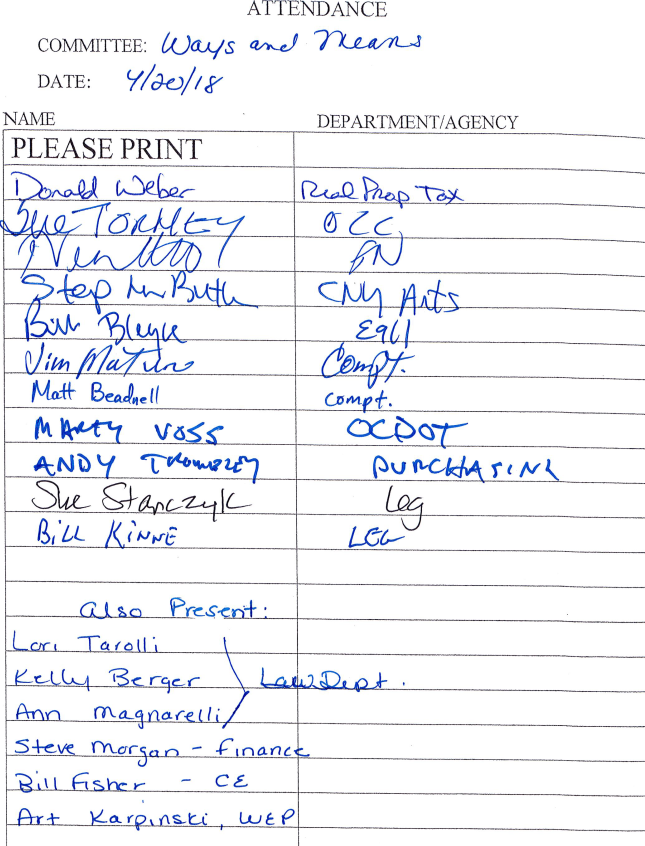
* * * |















































































